MAKE WAVES WITH THIS FREE WEEKLONG VOCABULARY UNIT!


How to Teach Paragraph Writing – Topic Sentences in Paragraph Writing
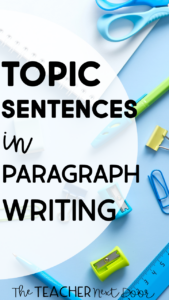
I’ve always loved writing, so it makes sense that I also love to teach writing.
Teaching writing though is not always easy. What seems so intuitive to us, does not always seem natural to our students.
So, when I teach paragraph writing, I like to teach paragraph writing as if it were a recipe…First, you add this kind of sentence, then you do that… While at first glance, we may think true writing is not based on a recipe, but I think it provides an awesome start.
Think about a child learning to read… we start with letters and sounds, not novels, right? How about learning to play an instrument, we start with single notes and not symphonies.
In the same way, I like to teach writing by starting at a very basic level, with the idea that as students master the paragraph’s components, they are eventually able to use those as a springboard to beautifully written, creatively thought-out pieces.
When they have a solid foundation for writing, they can augment the recipe like a master chef might change a recipe in the kitchen.
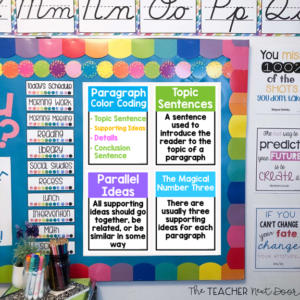
So, what exactly do I do in my classroom to teach paragraph writing? I decided to write a series of four blog posts, to explain it in more detail.
1. introduce the parts of a paragraph: color code and outline.
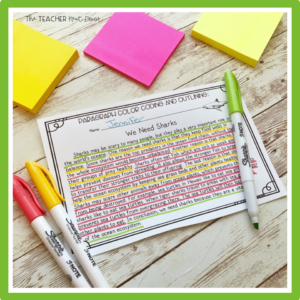
Once I introduce each part of the paragraph, I have students color-code a great deal, using paragraphs I’ve created or ones that previous students have crafted successfully. The example above shows a typical half-sheet paragraph, ready for color coding and outlining.
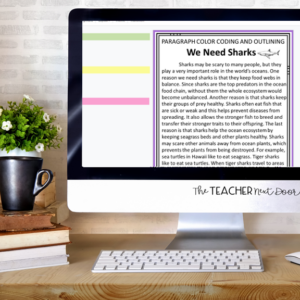
I like to place my copy on the document projector, while my students each have their own half-sheet. We go through the whole paragraph as a class, discussing each sentence and then color-coding it together.
The colors we use are: Topic Sentences and Conclusion Sentences are highlighted in green, Supporting Ideas are yellow and Details are pink.
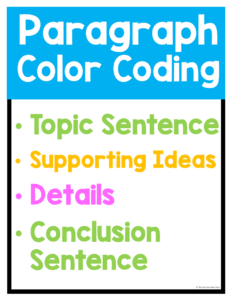
To highlight sentences, I let students use markers, colored pencils, or crayons so they can grab something quickly. Really, though, I prefer markers as they work the best to highlight papers. The one disadvantage to using markers is that they do tend to bleed through to the back of the paper where we do a reverse outline of the paragraph.
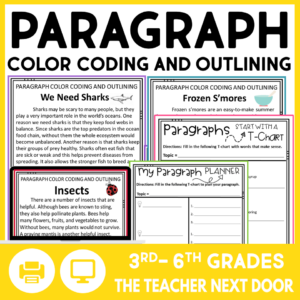
I really love the introductory color coding. It not only reinforces the concept of a paragraph and gives them a basic “recipe” for it, but these paragraphs serve as good writing models for students to follow.
Once we’ve finished color coding a paragraph, we flip our paper over and make a t-chart (words, not sentences) on the back in pencil. This reverse outlining reinforces the idea that every paragraph should have a certain organization and this is how the author organized his/her paragraph.
Here’s one of the T-Chart templates we use so you get a better idea of how students can create their own. The lightbulbs are for each of the supporting ideas (reasons that add proof to the topic sentence), and the numbers on the right are the details that provide examples and explanations that support each supporting idea.
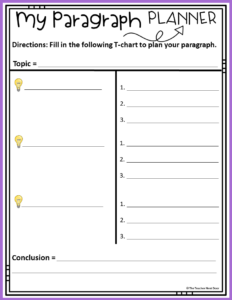
Of course, you can make your own paragraphs and materials for this but I do have a print and go resource to target these skills.
2. Introduce Different Types of Topic Sentences
When I was in school, I know we never were taught that there were different types of topic sentences, that each could be identified and named, so this was a really new idea to me but one I have since fallen in love with. I purposefully teach students five different ways to create a topic sentence, and we spend a few days working on each type.
It’s my feeling that if students in grades 3 – 6 (and even higher) can master a basic set of five topic sentences and use them with ease, this puts them in good stead as growing writers. We go over examples together, students write a sentence on their whiteboards as I give them a topic, and we discuss how there are lots of “right” answers when it comes to writing, but also some choices that are better than others.
Briefly, here are each of the five topic sentences I introduce:
1. list statements:.
A List Statement tells the reader exactly what the paragraph will be about by listing the three supporting ideas. For example: My favorite sports include soccer, football, and basketball.
2. Number Words:
Number Words do not tell the readers each of the supporting ideas but use number words (many, few, a number of, four…) to present the general topic. For example: There are several things you can do to become a better writer.
3. Two Nouns and Two Commas:
Two Nouns and Two Commas topic sentences always start with a noun (a person, place, or thing), describe it, and then make a statement about it (an appositive). The description part of the sentence is surrounded by commas (one before the description, and one after it). For example: Roald Amundsen, an explorer, was the first to find the Northwest Passage.
4. Occasion Position:
Occasion Position topic sentences start with an occasion (a dependent clause) and use words like when, whenever, although, even though. They end with the writer’s position on the topic (an independent clause). For example: Whenever we celebrate the holidays, we always include some special traditions.
5. Get Their Attention:
These topic sentences try to grab the reader’s attention by making a statement that is thought-provoking, controversial, or interesting. For example: The Italian Deli serves the best pastrami sandwiches downtown!
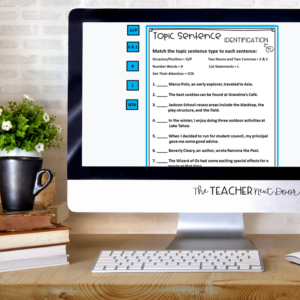
My Topic Sentence Resource explains each sentence type with lots more detail and has practice pages for each type as well.
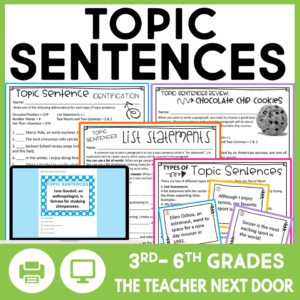
3. Review All Five Topic Sentence Types
Once students have a pretty good handle on the five types of topic sentences, I love to do this really fun chocolate chip cookie review lesson. I start by telling the story of how chocolate chip cookies were invented by accident (a copy of the story is included in the Topic Sentence packet).
Then we do the handout that has lots of different kinds of topic sentences that all deal with chocolate chip cookies. When we finish correcting together, I used to love to pass out cookies for the kids to share…until the Health and Wellness policy changed at our school, and it became a no-no…grrr.
We also love to play a sorting game (in the Topic Sentence packet) that has students working in pairs to match up the topic sentences with their sentence type. Once “official” review activities are finished, I keep right on reviewing as we work on writing throughout the year.
For example, sometimes we might be writing a paragraph for an essay and one student will give me a topic sentence example, I might ask the class what kind of topic sentence it was. Or I’ll say, our topic is __ . Who can make up an Occasion Position topic sentence for this topic?
Also, if you’d like the convenience of having all of the paragraph writing materials at your fingertips, you might want to take a peek at this deeply discounted bundle. It includes BOTH print AND digital formats!
Click here to take a look!
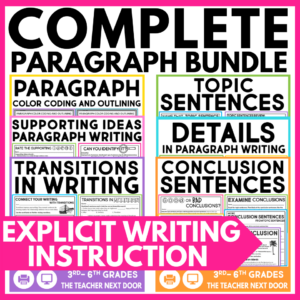
If you’d like to get more teaching ideas for paragraph writing, here are a few posts you might like:
Supporting Ideas and Details
Transitions
Conclusions
5 Tips for More Effective Paragraph Writing

- Read more about: Writing & Grammar
You might also like...
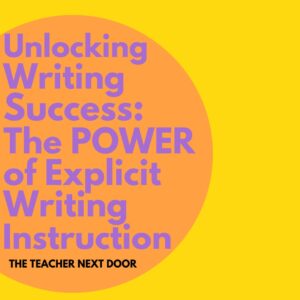
Unlocking Student Writing Success: The Power of Explicit Writing Instruction
As upper elementary teachers, our goal is to create strong writers. However, the lack of Explicit Writing Instruction has caused students in the US to
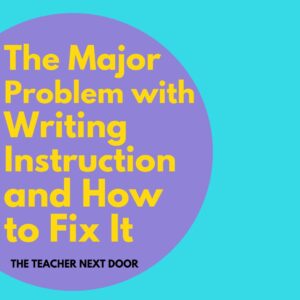
The Major Problem with Writing Instruction and How to Fix It
Writing instruction at the elementary level needs an overhaul. The last time the National Assessment of Education Progress (NAEP) measured 8th-grade students’ writing proficiency in
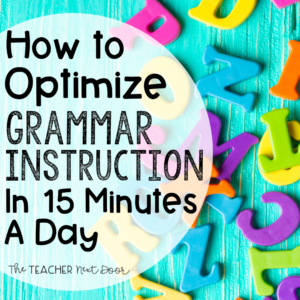
How to Optimize Grammar Instruction in 15 Minutes a Day
As elementary school teachers, we are always thinking about how to integrate subjects. History content and nonfiction text features. A science equation and a math
Hi, I’m Jenn, CEO and owner of The Teacher Next Door!
I know that you strive to be an effective upper elementary teacher while maintaining a healthy work-life balance.
In order to do that, you need resources that are impactful, yet simple .
The problem is that most resources and curriculums out there are far from simple. The pages upon pages of daily lesson plans are just plain overwhelming .
At TTND, we believe teachers should be living their lives outside of the classroom, and not spend hours lesson planning and searching for resources.
We understand that now, more than ever, teachers need space to be themselves which is why we create and support teachers with timesaving tips and standards-aligned resources.
Want access to TTND's Free Resource Library? Sign up for our newsletter and we'll email you the exclusive password!
Trending posts.

SEARCH BY TOPIC
- Classroom Ideas
- Holidays and Seasonal
- Mentor Texts
- Reading Block
- Uncategorized
- Writing & Grammar
POPULAR RESOURCES

Facebook Group
Teachers Pay Teachers
Free Resource Library
💌 Contact Us
Disclosures
Privacy Policy
Refund Policy
Purchase Orders
Your Downloads
Reward Points
© The Teacher Next Door, LLC. All rights reserved.

* Please note: If your school has strong email filters, you may wish to use your personal email to ensure access.
Check Out the New Website Shop!

Novels & Picture Books

Anchor Charts

Teaching Topic Sentences
By Mary Montero
Share This Post:
- Facebook Share
- Twitter Share
- Pinterest Share
- Email Share
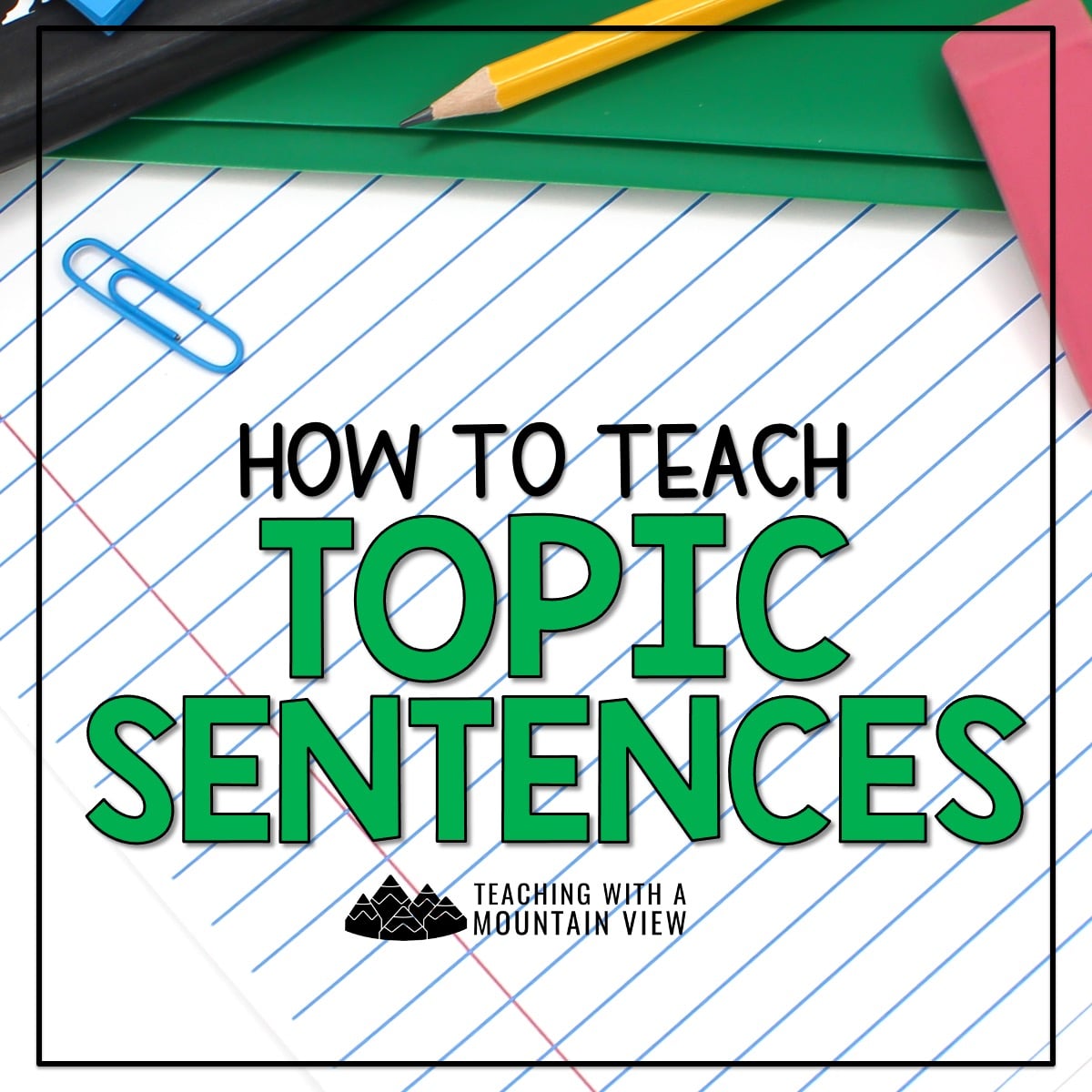
I am so lucky to be working side-be-side with the creator of an incredible writing program this year, and this topic sentences lesson is one big reason why! She and a former colleague (who I taught 3rd grade with) created the entire school-wide curriculum, and it is so cohesive! I’m LOVING it. I love having something that I can turn to and an excellent scope and sequence for writing. It’s especially fantastic because, as a school-wide program, the kids build on what they are learning year to year… which is why when I started teaching topic sentences this time, almost ALL of the kids were already familiar with the concept and the types of sentences we use. You can read more about the writing curriculum here.
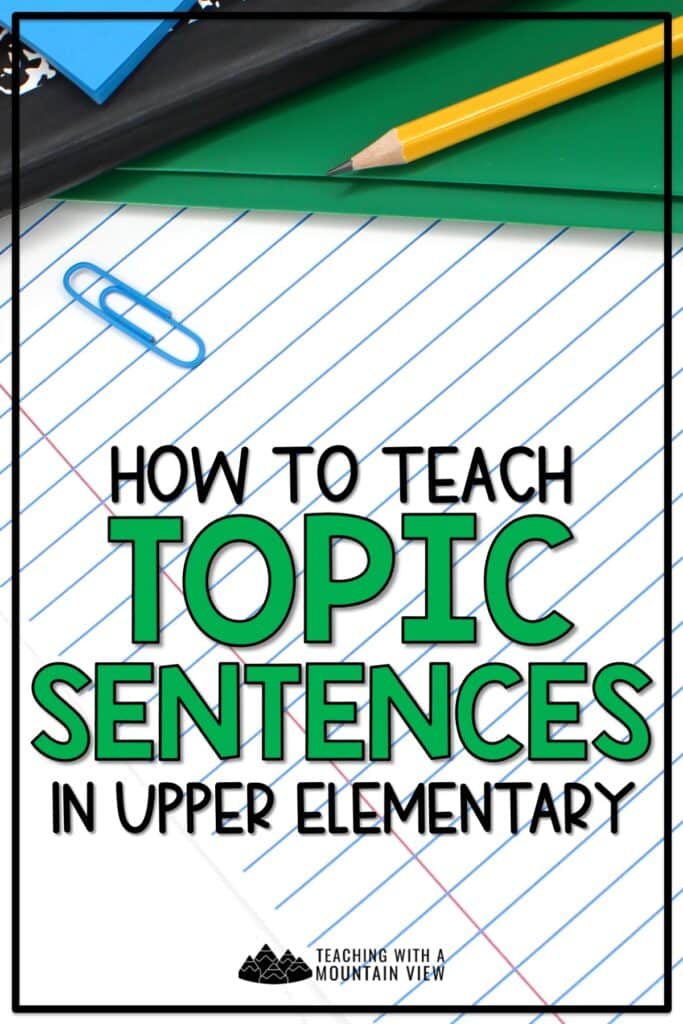
Teaching Topic Sentences Anchor Chart and Lesson
We started off with a quick introduction lesson on topic sentences. The Write Now Right Now curriculum has four types of topic sentences they teach, and they are great starters for kids.
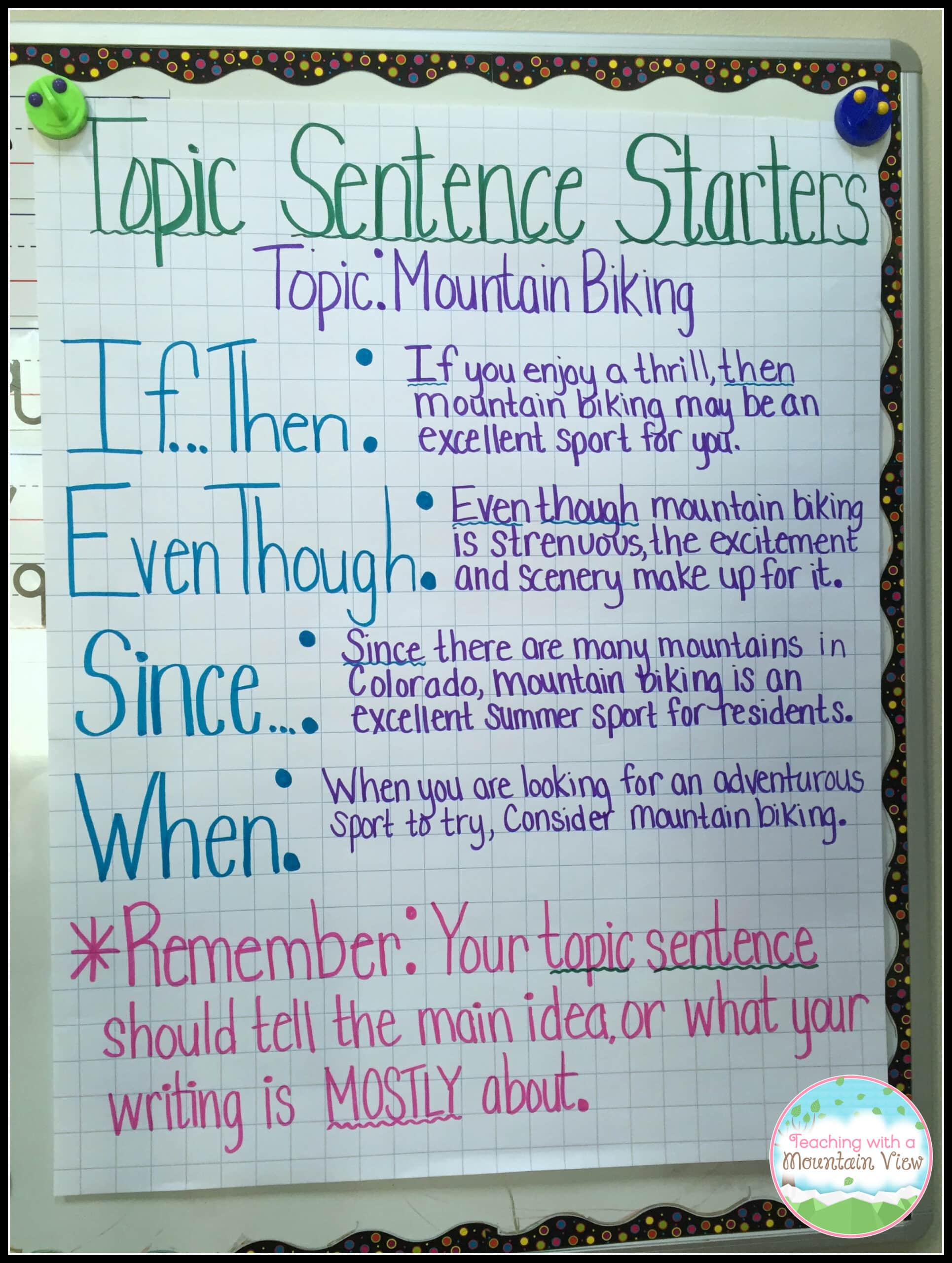
The four types of topic sentences we teach are If…Then, Even though, Since, and When. They catch on VERY quickly to these types of sentences!
They each wrote in their notebook the four types of sentences (here is a picture of my teacher notebook that I projected on the board). They wrote an example of each and they also wrote their own for a different topic (recess).
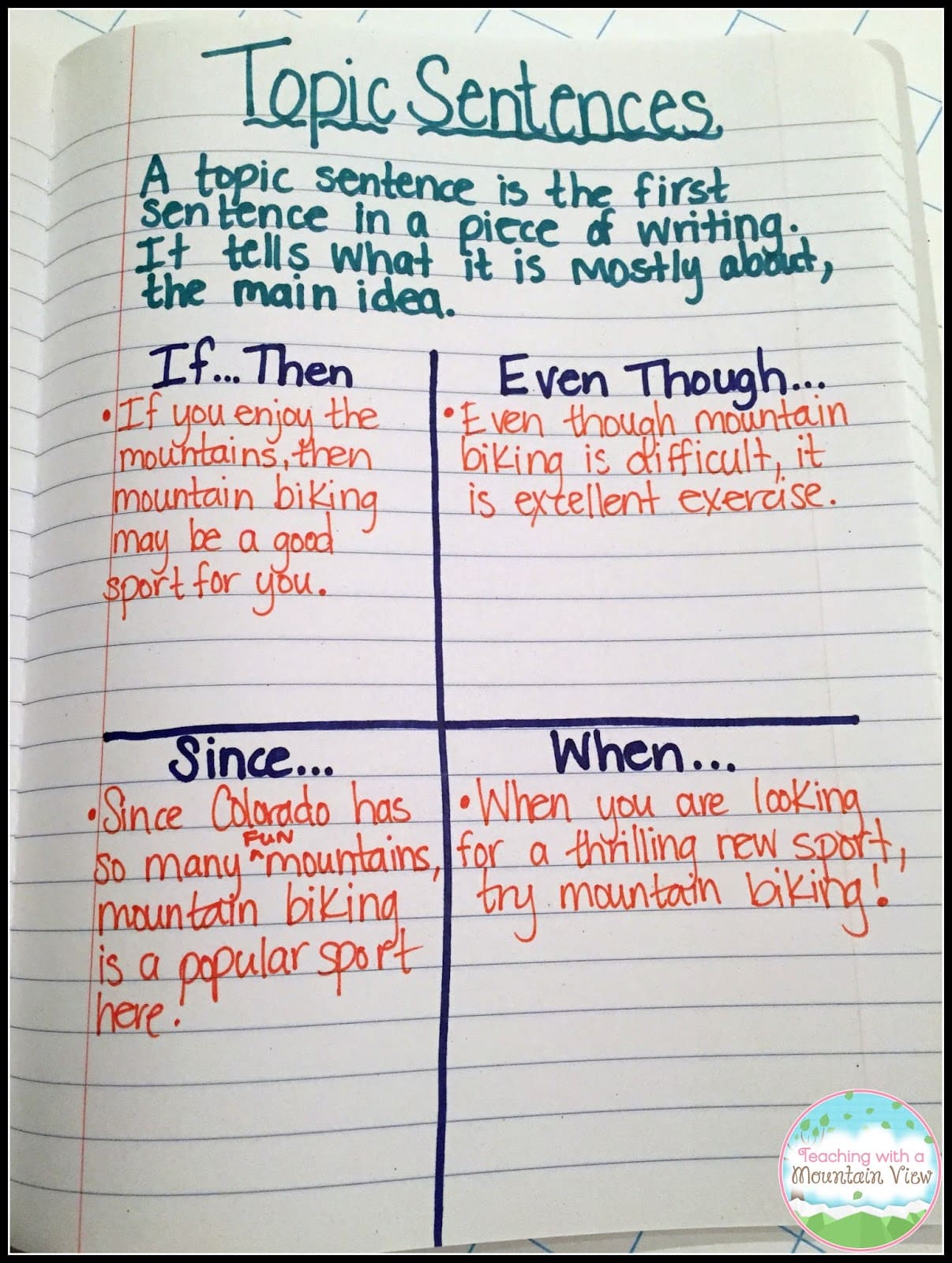
Now, even though our overall topic was mountain biking, we had a discussion about what the specific topics that go with each of these topic sentences would be… We wrote out the specific topics for each. The next step would be outlining the details to support the main topic.
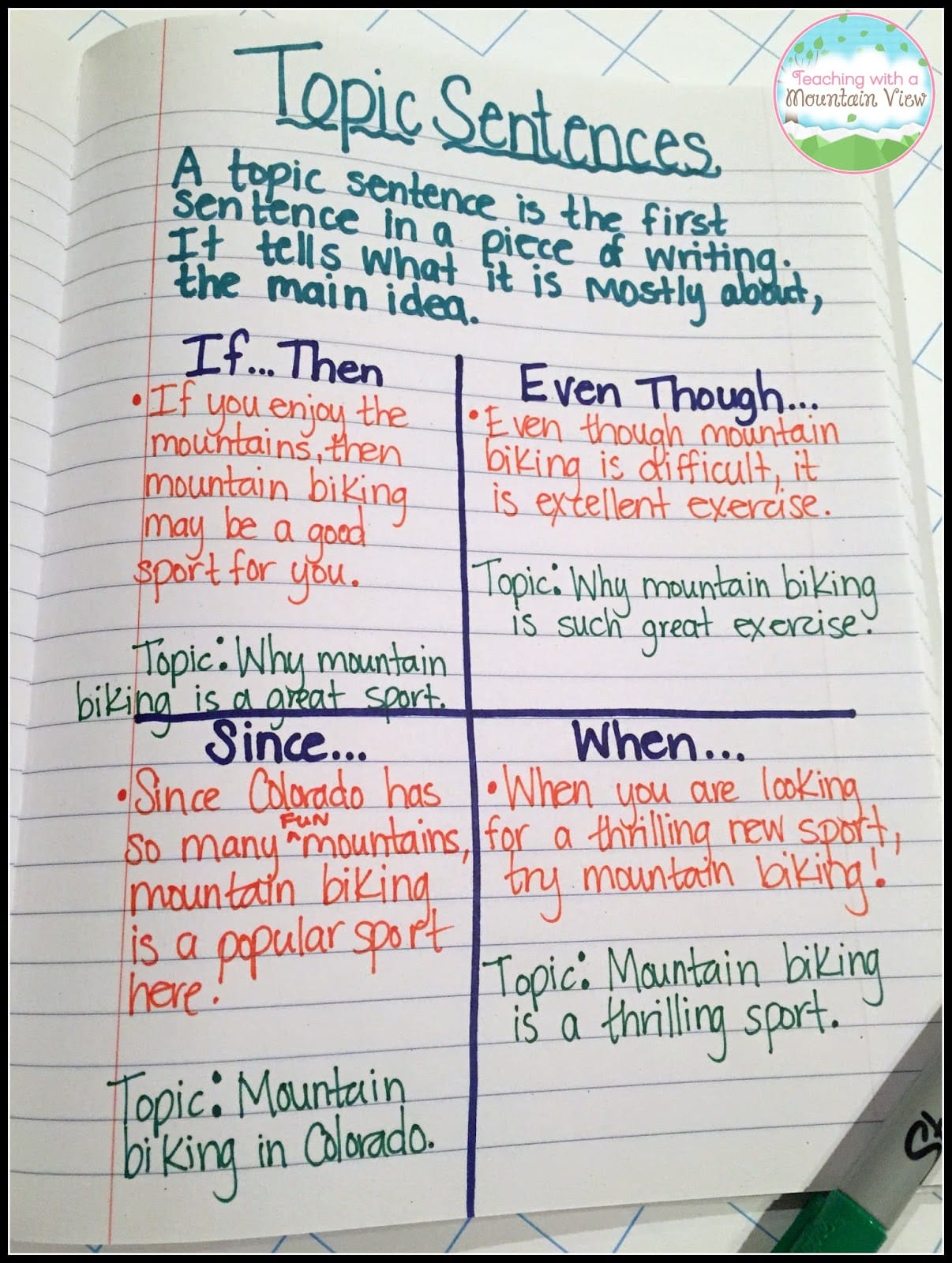
Here’s another example to use as part of your teaching topic sentences lesson.
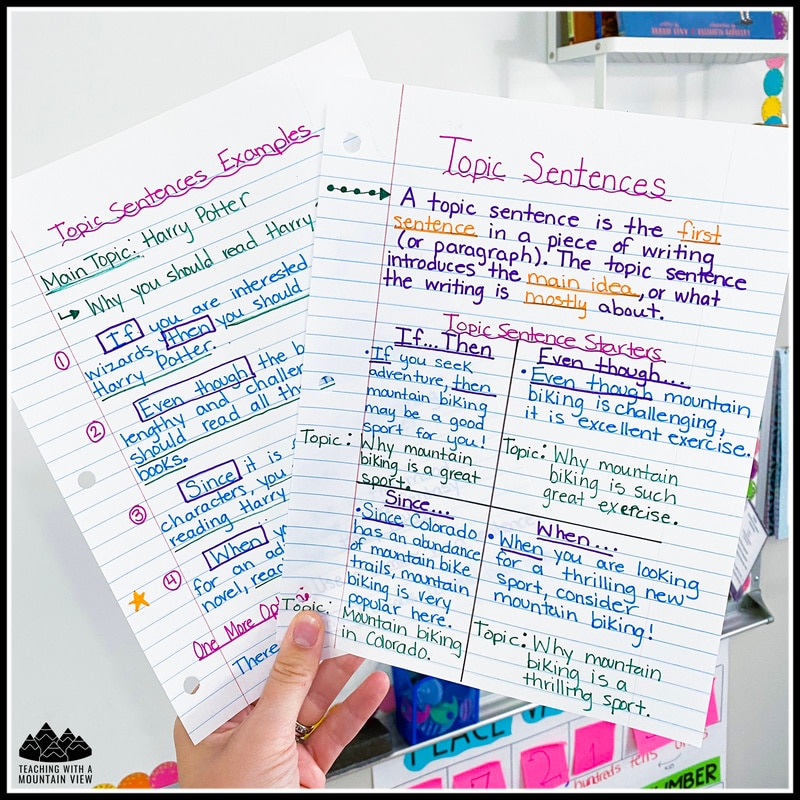
Topic Sentences Practice Activity
The next day, we did an activity inspired by Stephanie at Teaching in Room 6. Read her original blog post HERE , because it’s great and covers so many topics!
Since I didn’t have the same cards she used (or anything like it), I quickly typed up eight paragraphs. One set of paragraphs included topic sentences and the other didn’t. Most of my kids were doing really well, so I only used the one without topic sentences. You can use them however you like, but I designed them to be good for differentiating.
I put one paragraph each on a paper bag and put them around the room. In partners, the students rotated around the room, writing one of each type of topic sentence (as seen above). Then, they put it into the bag. So at the end, we had TONS of topic sentences in the bags, and the best part of it was that they were all unique! We pulled several from each bag to read and discuss. Nobody saw other people’s sentences until the end when we pulled them out, so they weren’t inspired by others… This is also a GREAT main idea assessment.
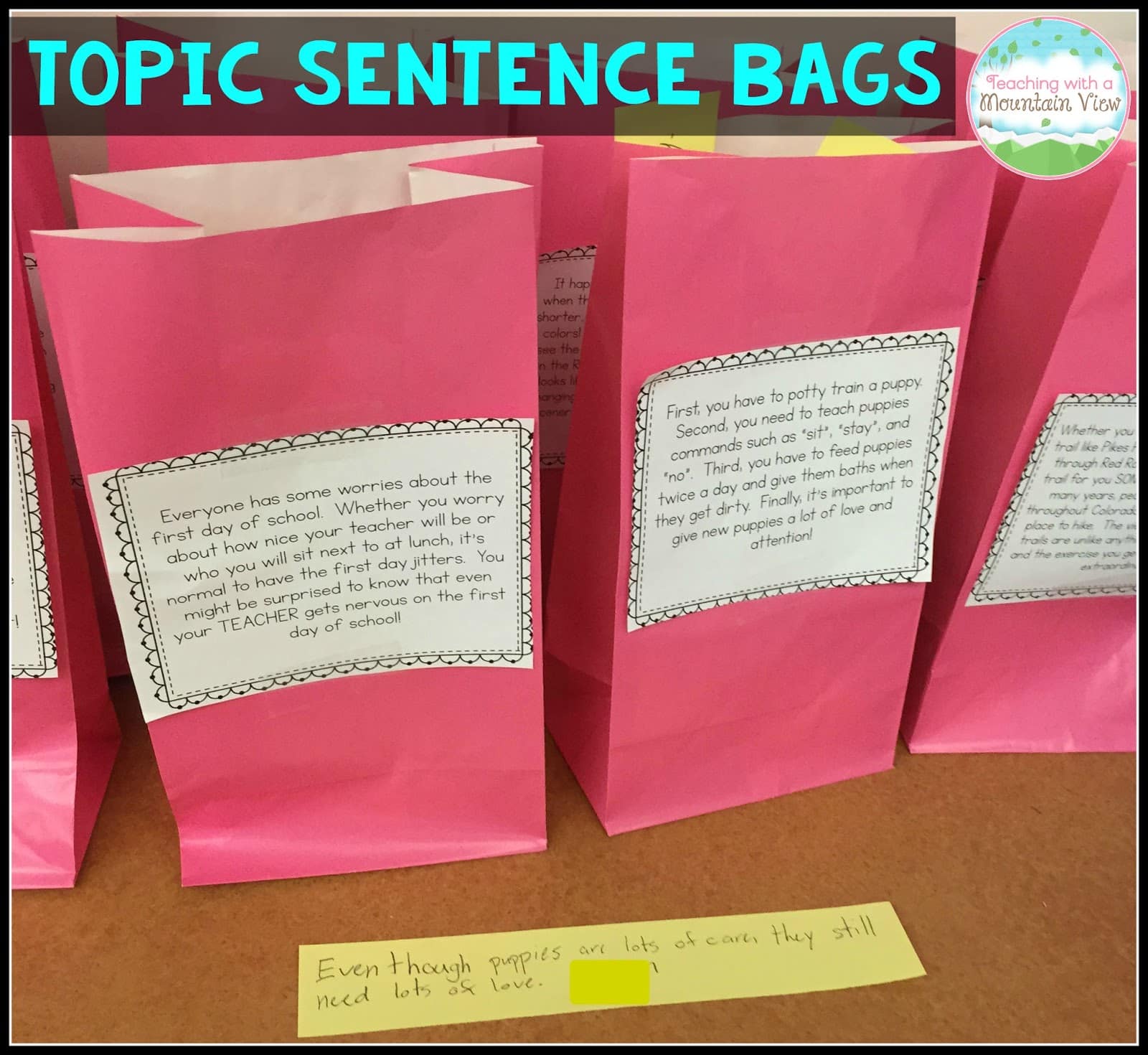
There are two almost identical sets. One without example topic sentences and one with. You can download the topic sentence cards for free HERE to use next time you’re teaching topic sentences.
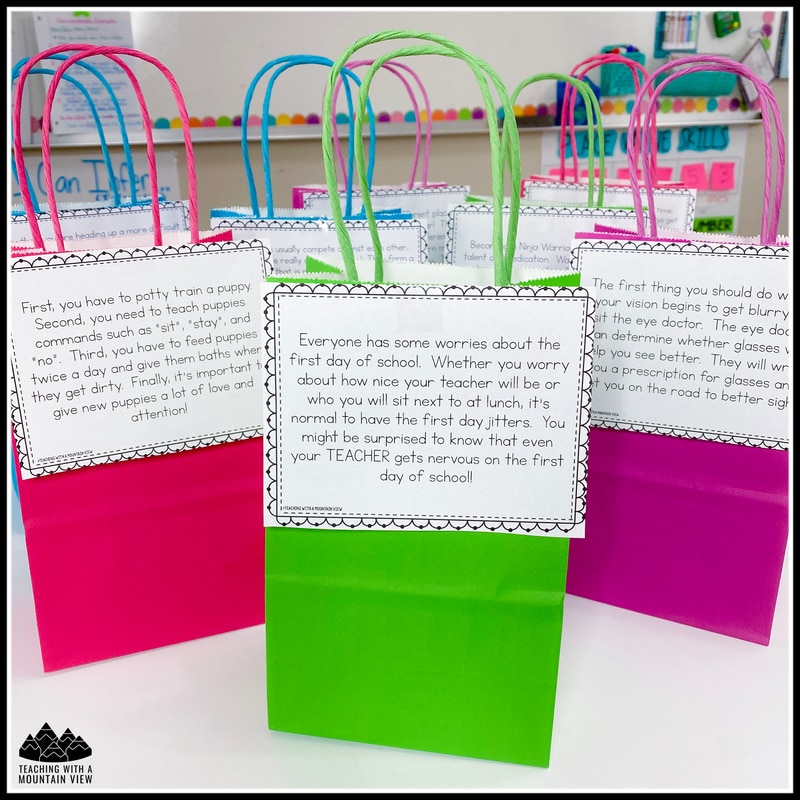
Topic Sentences in Writing
When it’s time for students to apply topic sentences to their own writing, I love using mentor texts. Using text exemplars as mentor texts to help students identify specific parts of all three writing genres will be a game-changer in your instruction! Every time I teach a specific component of writing — like creating the topic sentence in an informative text — I end up writing my own example as a mentor text for students to dissect.
After doing this for years, this incredible set of mentor texts was designed specifically to help you teach students about specific parts of writing . I have provided a model text, annotation guides and questions, and components that will help your students clearly identify and emulate the important parts of writing! This bundle includes informational text, narrative text, and opinion text lessons.
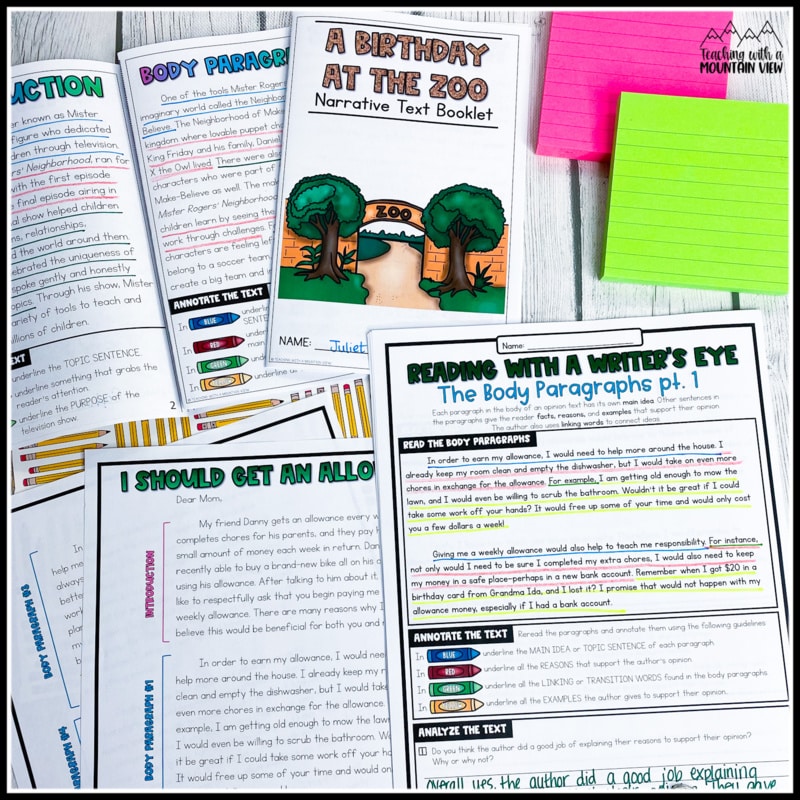
Looking for more writing tips? Read these posts !
Mary Montero
I’m so glad you are here. I’m a current gifted and talented teacher in a small town in Colorado, and I’ve been in education since 2009. My passion (other than my family and cookies) is for making teachers’ lives easier and classrooms more engaging.
You might also like…

Leave a Reply Cancel reply
Your email address will not be published. Required fields are marked *
I love this activity! Providing sentence structures for kids is such a great way to grow their writing skills and stretch their language. They have to be thoughtful to decide which would work best for their piece. Thanks for sharing this!
Buzzing with Ms. B
Thanks so much! I've adapted for middle school in prep for provincial exams! Love the differentiation and active involvement:)
Fantastic! Thank you for sharing! This is my first year teaching 4th (previously kinder) and I can use all the help I can get. These are perfect!
Awesome! Thanks for sharing!

©2023 Teaching With a Mountain View . All Rights Reserved | Designed by Ashley Hughes
Username or Email Address
Remember Me
Lost your password?
Review Cart
No products in the cart.
How to Teach Writing a Topic Sentence 6 Easy Tips
Teaching writing is one of those skills a teacher either loves or hates i was the latter until i learned to break writing down into very small steps. pretty soon, i was in love with teaching my upper elementary students how to write..
In all honesty, when I teach writing, I pretend that my students have never been taught how to write a paragraph at all! So, before I even dive into teaching my upper elementary students how to write a full paragraph, I kick things off by teaching them how to start a paragraph with a great topic sentence.
Topic Sentences for a Summary
Because most of my students re familiar with writing short summary paragraph, I start by teaching the “recipe” if you will on how to write a succinct topic sentence that gives the reader a glimpse into what they will read about without giving away the details.
The first method I teach is the T.A.G.S. method. T.A.G.S. stands for: Title, Author, Genre, State the main idea or synopsis.
For example, if we are summarizing the book Stone Fox by John Reynolds Gardiner, we would create a topic sentence that may read like this: Stone Fox , by John Reynolds Gardiner, is a realistic fiction novel about a young boy who enters a sled dog race to try to save his family’s farm.
Once we practice and master that skill, I like to add another tool to my students’ writing toolkit. We learn the I.W.A.S. model for writing a topic sentence. I.W.A.S. stands for Identify the title and the genre, Writer, give the writer credit, Action, what is the author doing, explaining, telling, entertaining, etc., State the main idea or synopsis.
For example, In the realistic fiction novel Stone Fox, the author John Reynolds Gardiner entertains us with a story about a young boy who enters a dog sled race to try to save his family farm.
We practice just the topic sentence for mastery.
Topic Sentences for an Informational Paragraph
Writing informational or non-fiction paragraphs are another important writing skill for upper elementary students. Students are expected to take a few facts and turn them into a 5 – 6 sentence paragraph. This is why I now focus on writing an interesting topic sentence for informational paragraphs next.
A topic sentence for an informational paragraph should “hook” the reader without giving away too many details.
To accomplish this goal, I teach my students a few tools to start their paragraphs in an interesting way.
- Use a bold statement.
- Use a quote.
- Ask a question.
- Cluster a few adjectives at the beginning of the sentence.
- Start your sentence with a conjunction.
One of my favorite activities to reinforce this skill is to have my students take dull and lifeless sentences and make them great!
Activities to Reinforce Topic Sentence Mastery
As any teacher will tell you, writing skills, like any other skill, needs to be reinforced. Here are some of my favorite activities for reviewing topic sentences.
One of the easiest activities to do this is a simple sort. I write a few topic sentences on a sheet of paper and give my students a list of six sentences. Their job is to sort which sentence could be included in a paragraph with that topic sentence and which could not be.
To review the components of a topic sentence, I love having my students play “Four Corners.” I prepare a PowerPoint that shows a title, an author, a genre type, or a main idea. Once students identify the category, they silently (I wish) move to the corner. This is a fun and quick way to review.
Task Cards make great “Take to Your Seat” activities for fast finishers or when you are pulling a small group. You can create a sentence sort, topic sentence vs. detail sentence, a TAGS sort, or even have your students put together silly topic sentences from task cares.
If you would like to save time and have an entire mini-unit on hand that explicitly teaches How to Write a Topic sentence, you may what to take a look at my “How to Write a Topic Sentence Unit.” This unit features all of the lessons and activities I have mentioned above in a print-and-go format.
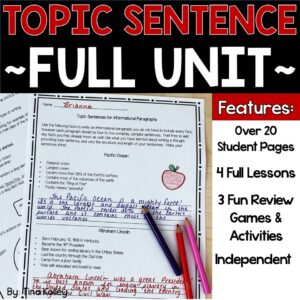
- Read more about: Blog
You might also like...
Partner color by codes in math 4 compelling reasons to use them.
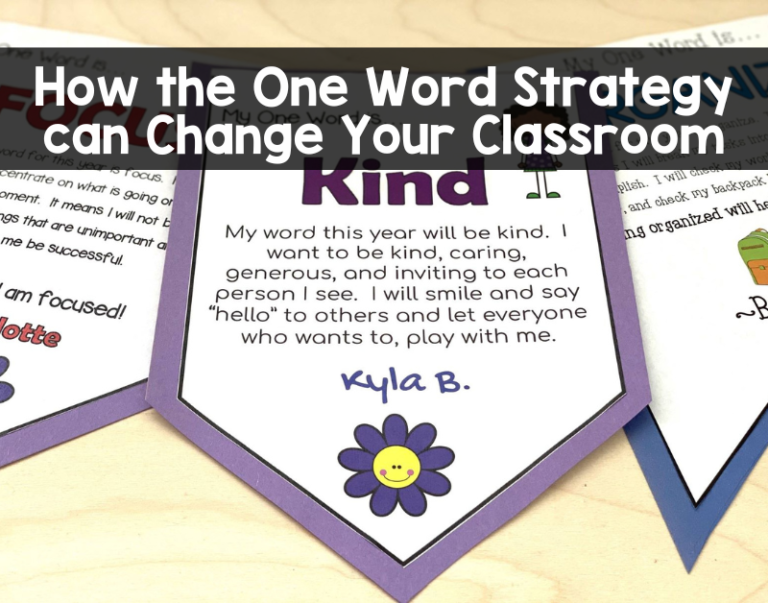
One Word Back to School Activities
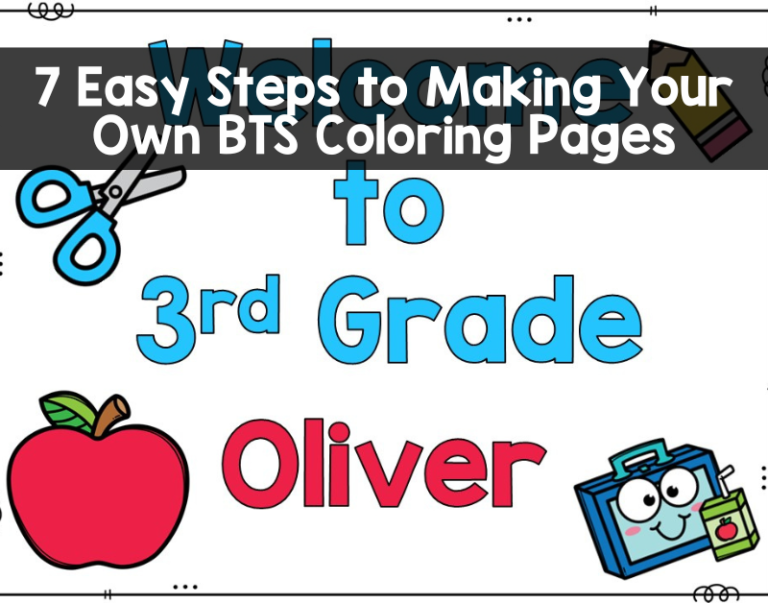
7 Easy Steps to Make Your Own Back to School Coloring Pages
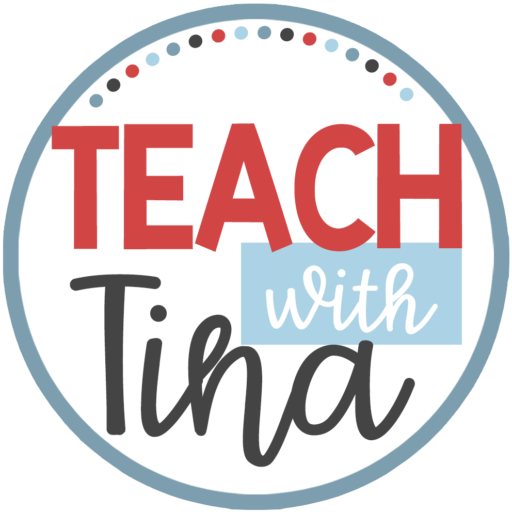
Have a language expert improve your writing
Run a free plagiarism check in 10 minutes, generate accurate citations for free.
- Knowledge Base
- Research paper
- How to Write Topic Sentences | 4 Steps, Examples & Purpose
How to Write Topic Sentences | 4 Steps, Examples & Purpose
Published on July 21, 2022 by Shona McCombes . Revised on June 5, 2023.
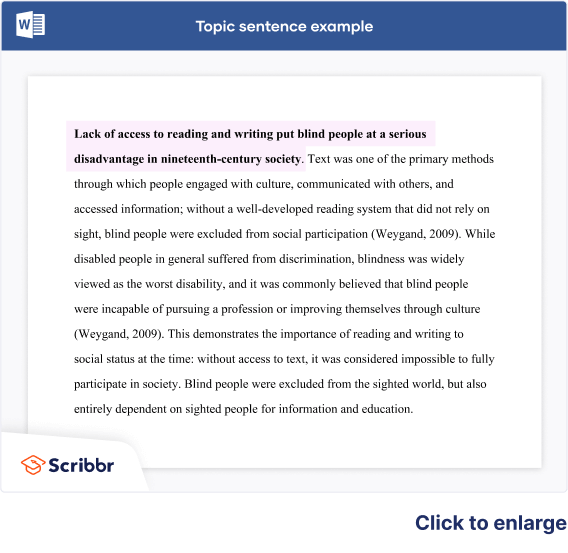
Every paragraph in your paper needs a topic sentence . The topic sentence expresses what the paragraph is about. It should include two key things:
- The topic of the paragraph
- The central point of the paragraph.
After the topic sentence, you expand on the point zwith evidence and examples.
To build a well-structured argument, you can also use your topic sentences to transition smoothly between paragraphs and show the connections between your points.
Instantly correct all language mistakes in your text
Upload your document to correct all your mistakes in minutes

Table of contents
Writing strong topic sentences, topic sentences as transitions between paragraphs, topic sentences that introduce more than one paragraph, where does the topic sentence go, frequently asked questions about topic sentences.
Topic sentences aren’t the first or the last thing you write—you’ll develop them throughout the writing process. To make sure every topic sentence and paragraph serves your argument, follow these steps.
Step 1: Write a thesis statement
The first step to developing your topic sentences is to make sure you have a strong thesis statement . The thesis statement sums up the purpose and argument of the whole paper.
Thesis statement example
Food is an increasingly urgent environmental issue, and to reduce humans’ impact on the planet, it is necessary to change global patterns of food production and consumption.
Step 2: Make an essay outline and draft topic sentences
Next, you should make an outline of your essay’s structure , planning what you want to say in each paragraph and what evidence you’ll use.
At this stage, you can draft a topic sentence that sums up the main point you want to make in each paragraph. The topic sentences should be more specific than the thesis statement, but always clearly related to it.
Topic sentence example
Research has consistently shown that the meat industry has a significant environmental impact .
Step 3: Expand with evidence
The rest of the paragraph should flow logically from the topic sentence, expanding on the point with evidence, examples, or argumentation. This helps keep your paragraphs focused: everything you write should relate to the central idea expressed in the topic sentence.
In our example, you might mention specific research studies and statistics that support your point about the overall impact of the meat industry.
Step 4: Refine your topic sentences
Topic sentences usually start out as simple statements. But it’s important to revise them as you write, making sure they match the content of each paragraph.
A good topic sentence is specific enough to give a clear sense of what to expect from the paragraph, but general enough that it doesn’t give everything away. You can think of it like a signpost: it should tell the reader which direction your argument is going in.
To make your writing stronger and ensure the connections between your paragraphs are clear and logical, you can also use topic sentences to create smooth transitions. To improve sentence flow even more, you can also utilize the paraphrase tool .
The only proofreading tool specialized in correcting academic writing - try for free!
The academic proofreading tool has been trained on 1000s of academic texts and by native English editors. Making it the most accurate and reliable proofreading tool for students.

Try for free
As you write each topic sentence, ask yourself: how does this point relate to what you wrote in the preceding paragraph? It’s often helpful to use transition words in your topic sentences to show the connections between your ideas.
Emphasize and expand
If the paragraph goes into more detail or gives another example to make the same point, the topic sentence can use words that imply emphasis or similarity (for example, furthermore , indeed , in fact , also ).
Indeed , cattle farming alone is responsible for a large proportion of greenhouse gas emissions.
Summarize and anticipate
If the paragraph turns to a different aspect of the same subject, the topic sentence can briefly sum up the previous paragraph and anticipate the new information that will appear in this one.
While beef clearly has the most dramatic footprint, other animal products also have serious impacts in terms of emissions, water and land use.
Compare and contrast
If the paragraph makes a comparison or introduces contrasting information, the topic sentence can use words that highlight difference or conflict (for example, in contrast , however , yet , on the other hand ).
However , the environmental costs of dietary choices are not always clear-cut; in some cases, small-scale livestock farming is more sustainable than plant-based food production.
You can also imply contrast or complicate your argument by formulating the topic sentence as a question.
Is veganism the only solution, or are there more sustainable ways of producing meat and dairy?
Sometimes you can use a topic sentence to introduce several paragraphs at once.
All of the examples above address the environmental impact of meat-eating versus veganism. Together, they make up one coherent part of a larger argument, so the first paragraph could use a topic sentence to introduce the whole section.
In countries with high levels of meat consumption, a move towards plant-based diets is the most obvious route to making food more sustainable. Research has consistently shown that the meat industry has significant environmental impacts.
The topic sentence usually goes at the very start of a paragraph, but sometimes it can come later to indicate a change of direction in the paragraph’s argument.
Given this evidence of the meat industry’s impact on the planet, veganism seems like the only environmentally responsible option for consumers. However, the environmental costs of dietary choices are not always clear-cut; in some cases, small-scale livestock farming is more sustainable than plant-based food production.
In this example, the first sentence summarizes the main point that has been made so far. Then the topic sentence indicates that this paragraph will address evidence that complicates or contradicts that point.
In more advanced or creative forms of academic writing , you can play with the placement of topic sentences to build suspense and give your arguments more force. But if in doubt, to keep your research paper clear and focused, the easiest method is to place the topic sentence at the start of the paragraph.
View topic sentences in an example essay
Receive feedback on language, structure, and formatting
Professional editors proofread and edit your paper by focusing on:
- Academic style
- Vague sentences
- Style consistency
See an example

A topic sentence is a sentence that expresses the main point of a paragraph . Everything else in the paragraph should relate to the topic sentence.
Topic sentences help keep your writing focused and guide the reader through your argument.
In an essay or paper , each paragraph should focus on a single idea. By stating the main idea in the topic sentence, you clarify what the paragraph is about for both yourself and your reader.
The topic sentence usually comes at the very start of the paragraph .
However, sometimes you might start with a transition sentence to summarize what was discussed in previous paragraphs, followed by the topic sentence that expresses the focus of the current paragraph.
Let’s say you’re writing a five-paragraph essay about the environmental impacts of dietary choices. Here are three examples of topic sentences you could use for each of the three body paragraphs :
- Research has shown that the meat industry has severe environmental impacts.
- However, many plant-based foods are also produced in environmentally damaging ways.
- It’s important to consider not only what type of diet we eat, but where our food comes from and how it is produced.
Each of these sentences expresses one main idea – by listing them in order, we can see the overall structure of the essay at a glance. Each paragraph will expand on the topic sentence with relevant detail, evidence, and arguments.
Cite this Scribbr article
If you want to cite this source, you can copy and paste the citation or click the “Cite this Scribbr article” button to automatically add the citation to our free Citation Generator.
McCombes, S. (2023, June 05). How to Write Topic Sentences | 4 Steps, Examples & Purpose. Scribbr. Retrieved April 8, 2024, from https://www.scribbr.com/research-paper/topic-sentences/
Is this article helpful?
Shona McCombes
Other students also liked, example of a great essay | explanations, tips & tricks, how to write a thesis statement | 4 steps & examples, transition words & phrases | list & examples, "i thought ai proofreading was useless but..".
I've been using Scribbr for years now and I know it's a service that won't disappoint. It does a good job spotting mistakes”

Honing Topic Sentences
This variation of thesis-speed-dating asks students to peer edit topic sentences in a round-robin style, helping them better understand the structure and function of effective topic sentences.
Author: Lindsey Mantoan
Class: PWR 1/PWR 2
Activity brief description: The goal of this activity is to focus students’ attention on their use of topic sentences. Once they have a full draft of an assignment, they copy and paste all of their topic sentences into a single paragraph on a separate document. This paragraph allows them to zoom in and see how their topic sentences relate to their thesis and to each other.
Schedule: Week 8-9 (but could be used any time between the draft of an assignment and the due date for the final version of that assignment)
Activity length: Appox. 40 minutes
Activity goals: Sharpen use of topic sentences; focus on structure, trajectory, and argument
Activity details:
- Preparation: Make sure students know to bring a laptop to class and to have the electronic file of their draft accessible.
- Students first copy and paste all of their topic sentences from their draft into a blank document, putting them into a single paragraph
- They read the paragraph to see if it creates a coherent essay in its own right, and if it reflects the arguments they want to make in the essay as a whole
- I sometimes ask students to count how many words are in some of their topic sentences (which generates laughs) and ask them to cut at least five words from every sentence over 30 words
- Students then rotate one chair to their right, and read through their neighbor’s topic sentences. They offer questions, comments, suggestions, etc. in the word document (they can use different fonts/colors for this). Students have, say, 4-5 minutes at each seat.
- Students rotate another seat, commenting both on the new set of topic sentences and also on previous comments/suggestions
- After rotating four or five chairs, students return to their own seat and read through the suggestions their peers gave them. They then take five minutes to revise some of their sentences based on what they’ve learned.
- I ask students what trends they’ve noticed in their topic sentences: Are they argumentative or descriptive? Do they refer back to the thesis? Do they have a clear and logical trajectory? Does it seem like the topic sentences do the heavy lifting in the essay
- I also ask what they learned from reading other people’s topic sentences.
- I encourage students to repeat this exercise on their own after additional rounds of revisions.
Additional notes: Originally published as an Activity of the Week, winter 2015
How to Teach Topic Sentences Using Models
Crafting Good Topic Sentences That Focus the Reader
David Lees / Getty Images
- Teaching Resources
- An Introduction to Teaching
- Tips & Strategies
- Policies & Discipline
- Community Involvement
- School Administration
- Technology in the Classroom
- Teaching Adult Learners
- Issues In Education
- Becoming A Teacher
- Assessments & Tests
- Elementary Education
- Secondary Education
- Special Education
- Homeschooling
- M.Ed., Curriculum and Instruction, University of Florida
- B.A., History, University of Florida
Topic sentences can be likened to miniature thesis statements for individual paragraphs. The topic sentence states the main idea or topic of the paragraph . The sentences that follow the topic sentence must relate and support the claim or position made in the topic sentence.
As with all writing, teachers should first model proper topic sentences to have students identify the topic and the claim in the sentence, regardless of the academic discipline.
For example, these models of topic sentences inform the reader about a topic and the claim that will be supported in the paragraph:
- Topic Sentence: " Pets are important to many people because they can improve the overall health of the pet owner."
- Topic: "Pets"
- Claim: "Improve the overall health of the pet owner."
- Topic Sentence: "Coding requires a number of different skills."
- Topic: "Coding"
- Claim: "Requires a number of different skills."
- Topic Sentence: " There are many reasons why housing in Singapore is the best in the world."
- Topic: “Housing in Singapore”
- Claim: "Housing in Singapore is the best in the world."
- Topic Sentence: " Drama class requires students to be collaborative and willing to take risks."
- Topic: "Drama class"
- Claim: "Drama class requires students to be collaborative and willing to take risks."
Writing the Topic Sentence
The topic sentence should not be too general or too specific. The topic sentence should still provide the reader with the basic 'answer' to the question being posed. A good topic sentence should not include details. Placing the topic sentence at the beginning of a paragraph ensures that the reader knows precisely what information is going to be presented.
Topic sentences should also alert the reader as to how the paragraph or the essay has been organized so that the information can be better understood. These paragraph text structures can be identified as compare/contrast , cause/effect , sequence, or problem/solution .
As with all writing, students should be given multiple opportunities to identify topics and claims in models. Students should practice writing topic sentences for many different topics in all disciplines using different test structures.
Compare and Contrast Topic Sentences
The topic sentence in a comparison paragraph would identify the similarities or similarities and differences in the topic of the paragraph. A topic sentence in a contrast paragraph would identify only differences in topics. The topic sentences in compare/contrast essays may organize the information subject by subject (block method) or point by point. They may list comparisons in several paragraphs and then follow those with contrast points. The topic sentences of comparison paragraphs may use transition words or phrases such as ƒ as well as, correspondingly, ƒ compared to, just like, likewise, similarly, and the same as. Topic sentences of contrast paragraphs may use transition words or phrases such as: although, conversely, even though, however, in contrast, on the other hand, to the contrary, and unlike. ƒ
Some examples of compare and contrast topic sentences are:
- "Animals in the same family share common characteristics. These characteristics include…"
- "A purchase of a small car has both advantages and disadvantages."
Cause and Effect Topic Sentences
When a topic sentence introduces the effect of a topic, the body paragraphs will contain evidence of causes. Conversely, when a topic sentence introduces a cause, the body paragraph will contain evidence of effects.
Transition words used in topic sentences for a cause and effect paragraph may include:
- Accordingly
- As a result
- Consequently
- For this reason
Some examples of topic sentences for cause and effect paragraphs are:
- "I am great at a grilling a steak, but I can never seem to make a good cake. This is because…"
- "The United States Civil War was started for a number of reasons. The causes of the Civil War include:"
- "The Great Depression was a period of great distress and economic problems for many Americans and individuals across the globe. The effects of the Great Depression include:"
Some essays require students to analyze the cause of an event or action. In analyzing this cause, students will need to discuss the effect or consequences of an event or action. A topic sentence using this text structure can focus the reader on the cause(s), the effect(s), or both. Students should remember not to confuse the verb "affect" with the noun "effect." The use of effect means “to influence or change” while the use of effect means “the result.”
Sequence Topic Sentences
While all essays follow a specific order, a text structure of sequence explicitly alerts the reader to a 1st, 2nd or 3rd point . A sequence is one of the most common strategies in organizing an essay when the topic sentence identifies a need to order the supporting information. Either the paragraphs must be read in order, much like a recipe, or the writer has prioritized the information using terms such as then, next or finally .
In a sequence text structure, the body paragraph follows a progression of ideas that are supported by details or evidence.
The transition words that could be used in topic sentences for sequence paragraphs may include:
- Subsequently
Some examples of topic sentences for sequence paragraphs are:
- "The first reason why a real Christmas tree is preferred by many to an artificial one is:"
- "Successful leaders of large companies often share similar traits. The most important trait includes:"
- "Changing the oil in a car is easy only if you follow the steps."
Problem-Solution Topic Sentences
The topic sentence in a paragraph that uses the problem/solution text structure identifies a problem for the reader. The remainder of the paragraph is dedicated to offering a solution. Students should be able to provide a reasonable solution or refute objections in each paragraph.
Transition words that can be used in topic sentences using the problem-solution paragraph structure are:
Some examples of topic sentences for problem-solution paragraphs are:
- "Students can avoid getting sick when they go away to college by taking certain precautions. Proposed precautions include..."
- "Various health agencies suggest that many kinds of pollution can affect your health. The different kinds of pollution include…"
- "Texting while driving has increased the number of auto fatalities. One answer to this problem could be…"
All of the example sentences above can be used with students to illustrate the different types of topic sentences. If the writing assignment requires a particular text structure, there are specific transition words that can help students organize their paragraphs.
Crafting Topic Sentences
Crafting an effective topic sentence is a necessary skill, especially in meeting college and career readiness standards . The topic sentence requires that student plan what they are trying to prove in the paragraph before the draft. A strong topic sentence with its claim will focus the information or message for the reader. In contrast, a weak topic sentence will result in an unorganized paragraph, and the reader will be confused because the support or details will not be focused.
Teachers should be ready to use models of proper topic sentences to help students determine the best structure for delivering information to the reader. There must also be time for students to practice writing topic sentences.
With practice, students will learn to appreciate the rule that a proper topic sentence almost lets the paragraph to write itself!
- The Ultimate Guide to the 5-Paragraph Essay
- Beef Up Critical Thinking and Writing Skills: Comparison Essays
- Expository Essay Genre With Suggested Prompts
- How to Help Your 4th Grader Write a Biography
- Paragraph Writing
- What Is a Topic Sentence?
- Definition and Examples of Body Paragraphs in Composition
- Understanding General-to-Specific Order in Composition
- How to Structure an Essay
- What Is Expository Writing?
- Development in Composition: Building an Essay
- Writing Cause and Effect Essays for English Learners
- How to Write Your Graduate School Admissions Essay
- Supporting Detail in Composition and Speech
- Best Practices for the Most Effective Use of Paragraphs
- How To Write an Essay
- Professional development
- Knowing the subject
- Teaching Knowledge database T-W
Topic sentence
The topic sentence is a sentence in a paragraph which shows what the paragraph is about and works as a summary of it.

It is often the first sentence of the paragraph.
Example In this paragraph the topic sentence is the first: Motivation is one of the key factors that determine the rate and success of L2 attainment . It provides the main incentive to initiate learning a foreign language and later the determination to persevere and sustain the long and often difficult learning process. Without sufficient motivation, even individuals with the best of abilities cannot accomplish long-term goals. Teachers working in state schools are first and foremost supposed to teach the curriculum, but we cannot ignore the fact that this cannot happen without motivating our learners. In addition, adolescent learners come with their own emotional and psychological baggage and interests making the task of motivating them one of the greatest challenges for teachers.
In the classroom Teaching learners how to identify topic sentences is a good idea, especially for exams. Learners can be encouraged to highlight the topic sentence in each paragraph as they read. An effective extension activity is to then use these as the basis for summary writing.
Further links: https://www.teachingenglish.org.uk/article/teaching-exam-based-writing-skills https://www.teachingenglish.org.uk/article/planning-a-writing-lesson https://www.teachingenglish.org.uk/article/shakespeare-comedy
Research and insight
Browse fascinating case studies, research papers, publications and books by researchers and ELT experts from around the world.
See our publications, research and insight
- Tpt-icon-iii

Teach Students How to Write Topic Sentences
Over the years, I’ve tried so many different ways to teach students how to write topic sentences. And, I’ve definitely learned that if I assume students know how to write one, I end up kicking myself for not starting with the basics! This year, something popped in my head that seemed to help my students, so I wanted to share it.
My magic idea? Umbrellas!
I was trying to find a way to teach students how to write a topic sentences for an introduction and topic sentences for each body paragraph in an argumentative essay when I stumbled upon the idea. I drew a large umbrella around my topic sentence in my introduction. I explained that everything in the paper would have to fit under this umbrella. For the three body paragraphs, I drew smaller umbrellas. I told students that while each body paragraph had its own topic sentence (umbrella), these three topic sentences still had to fit under the larger umbrella – topic sentence for the entire essay. The illustration explains it better!

This is basically what I said to my students to explain: The topic sentence in the introduction is like an umbrella, a big huge one that lots of people could fit under. You see, everything in the entire paper must fit under this big umbrella and that’s why you must choose a good one. Then, in each of the three body paragraphs, there is also a topic sentence- represented by smaller umbrellas. Only the information in that paragraph must fit under it. However, this umbrella still fits under the big one in the introduction.
If my big umbrella is something like “The Burmese python is a beautiful creature” then all of my small umbrellas will have to be something about what makes the snakes beautiful. This would be hard to do. Under my first small umbrella, I might write the following topic sentence: The patterns on the snakes body make the Burmese python beautiful. This works well as it fits under my big umbrella. However, I can’t think of anything else to say under my next two umbrellas. There is just no way I can write that many paragrraphs about why this snake is beautiful. This means one thing, my topic sentence under my big umbrella is not a good one. I need something else. What if I changed it to the following: The Burmese python is an interesting creature. ? Now, i’ts much easier to come up with my smaller topic sentences for the body of my paper. I can still use the umbrella about the snake being beautiful, but under my next umbrella, I can write the following topic sentence: The Burmese python has interesting eating habits. Under the last umbrella, I could write the following topic sentence: The Burmese python kills its prey in a unique way.
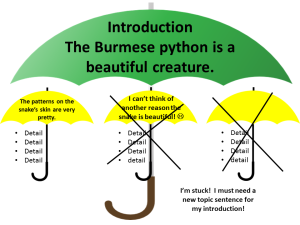
So far, this illustration I used to teach students how to write topic sentences has been wonderful! I even brought in a big umbrella and a smaller one as an illustration. My next idea is to look for the “umbrellas” in informational texts. Hopefully this will help us with identifying main ideas too.
You can print all of the illustrations above by clicking here.
Happy Teaching!

Recent Posts
- 2024 Cicadas ELA Activity and Fun Solar Eclipse ELA Lessons!
- Laying the ELA Foundation: Essential Skills for Middle School Students
- From Expectations to Efficiency: Essential Techniques for Classroom Management
- One-Pager Assignment in ELA
- What it Takes to Manage a Middle School ELA Classroom
- Bell Ringers
- Common Core
- Free Sample Lesson Plans
- Free short story lesson plans
- Holiday Lessons
- Interactive Activities
- Novel Unit Free Handouts
- Short Story
- Teach Grammar
- Teach Reading
- Teach Writing
- Teaching Tips
Sign Up for Email Updates


How to Teach "Writing a Topic Sentence"

Help for Primary Students to Write Good Sentences
After providing a clear explanation of what a topic sentence is, teachers can choose from a variety of age-appropriate activities that teach students to identify and create effective topic sentences. Teachers should explain to students that writing strong topic sentences will help them stay focused on their topics.
Explaining Topic Sentences
After defining the term “topic sentence,” transition to using examples of paragraphs with clear topic sentences. Give students a handout with the paragraphs and read them aloud. For lower grade levels, use paragraphs that have about four or five sentences. After reading the paragraph, ask students if they can identify the topic sentence. Explain how to identify supporting details and how they relate to the topic sentence. To help students understand the differences between topic sentences and supporting sentences, draw a comparison to something familiar. Teacher Kathryn Reilly compares topic sentences to music conductors; they direct all the sentences in front of them. The supporting sentences are like the musicians, who work together to create a cohesive song.
Identifying Sentences in Groups
Have students work in groups to solidify their understanding of topic sentences. Give students in upper elementary grades a handout with simple paragraphs. Instruct groups to underline the topic sentences in red and the supporting paragraphs in yellow. Remind groups that there should only be one sentence underlined in red per paragraph. Give students in middle or high school an envelope with four sentences, each on its own strip of paper. In groups, have them organize the sentences in a logical order, beginning with the topic sentence. Ask them to highlight the strip that is the topic sentence. You can also give middle and high school students an envelope with three to five supporting sentences written on the outside, and a card with the topic sentence inside. They must create a topic sentence for those detail sentences and write it down; then they can check the card on the inside to see how close they came.
Creating Topic Sentences
Now that students can identify topic sentences, have them write topic sentences and paragraphs on their own. Give upper elementary and middle school students a topic, such as “pets” and instruct them to write a detailed yet not too specific topic sentence, such as, “My dog Charlie is a loving and loyal pet.” The supporting sentences should explain how or why Charlie is loving and loyal. You can give elementary students a handout with a paragraph template with space for a topic sentence and three supporting sentences. Have students read their paragraphs aloud to the class, and ask fellow students to identify the topic sentence. You can give high school students a paragraph without a topic sentence or with a poorly written topic sentence, and instruct them to create one or make the current one better.
Writing Better Sentences
Once students grasp the idea of topic sentences, further their understanding by helping them to create better sentences and to think critically about their writing; these skills are particularly important for high school students preparing for college or standardized tests. For elementary or middle school students, read simple paragraphs with poorly constructed topic sentences, such as ones that assume the reader already knows about the subject, paragraphs that start with details rather than a main idea or sentences that don’t grab a reader’s interest. Work together to write a sentence that is more intriguing. For example, turn the sentence “Music is fun” into “I love listening to music because it relaxes me and makes me think about important things.” Challenge high school students to write a simple essay about a favorite topic. Have them write a thesis statement first, followed by three topic sentences that will serve as the first sentences of three body paragraphs.
Related Articles


Fun Games & Activities for Teaching English in Junior High School

What Is a High School Level Narrative Paragraph?

English Grammar Projects

How to Write an Essay Explaining a Concept

Kinesthetic Classroom Activities

How to Teach Middle School Students to Write a Thesis Sentence

How to Write a Five Sentence Paragraph in Elementary

Grammar Games With Active and Passive Voice
- Purdue Online Writing Lab Engagement: Topic Sentences
- Sophia.org: Writing Effective Topic Sentences
- Virginia Department of Education: Lesson Skill: Writing a Topic Sentence
Cara Batema is a musician, teacher and writer who specializes in early childhood, special needs and psychology. Since 2010, Batema has been an active writer in the fields of education, parenting, science and health. She holds a bachelor's degree in music therapy and creative writing.
Classroom Q&A
With larry ferlazzo.
In this EdWeek blog, an experiment in knowledge-gathering, Ferlazzo will address readers’ questions on classroom management, ELL instruction, lesson planning, and other issues facing teachers. Send your questions to [email protected]. Read more from this blog.
Four Strategies for Effective Writing Instruction

- Share article
(This is the first post in a two-part series.)
The new question-of-the-week is:
What is the single most effective instructional strategy you have used to teach writing?
Teaching and learning good writing can be a challenge to educators and students alike.
The topic is no stranger to this column—you can see many previous related posts at Writing Instruction .
But I don’t think any of us can get too much good instructional advice in this area.
Today, Jenny Vo, Michele Morgan, and Joy Hamm share wisdom gained from their teaching experience.
Before I turn over the column to them, though, I’d like to share my favorite tool(s).
Graphic organizers, including writing frames (which are basically more expansive sentence starters) and writing structures (which function more as guides and less as “fill-in-the-blanks”) are critical elements of my writing instruction.
You can see an example of how I incorporate them in my seven-week story-writing unit and in the adaptations I made in it for concurrent teaching.
You might also be interested in The Best Scaffolded Writing Frames For Students .
Now, to today’s guests:
‘Shared Writing’
Jenny Vo earned her B.A. in English from Rice University and her M.Ed. in educational leadership from Lamar University. She has worked with English-learners during all of her 24 years in education and is currently an ESL ISST in Katy ISD in Katy, Texas. Jenny is the president-elect of TexTESOL IV and works to advocate for all ELs:
The single most effective instructional strategy that I have used to teach writing is shared writing. Shared writing is when the teacher and students write collaboratively. In shared writing, the teacher is the primary holder of the pen, even though the process is a collaborative one. The teacher serves as the scribe, while also questioning and prompting the students.
The students engage in discussions with the teacher and their peers on what should be included in the text. Shared writing can be done with the whole class or as a small-group activity.
There are two reasons why I love using shared writing. One, it is a great opportunity for the teacher to model the structures and functions of different types of writing while also weaving in lessons on spelling, punctuation, and grammar.
It is a perfect activity to do at the beginning of the unit for a new genre. Use shared writing to introduce the students to the purpose of the genre. Model the writing process from beginning to end, taking the students from idea generation to planning to drafting to revising to publishing. As you are writing, make sure you refrain from making errors, as you want your finished product to serve as a high-quality model for the students to refer back to as they write independently.
Another reason why I love using shared writing is that it connects the writing process with oral language. As the students co-construct the writing piece with the teacher, they are orally expressing their ideas and listening to the ideas of their classmates. It gives them the opportunity to practice rehearsing what they are going to say before it is written down on paper. Shared writing gives the teacher many opportunities to encourage their quieter or more reluctant students to engage in the discussion with the types of questions the teacher asks.
Writing well is a skill that is developed over time with much practice. Shared writing allows students to engage in the writing process while observing the construction of a high-quality sample. It is a very effective instructional strategy used to teach writing.

‘Four Square’
Michele Morgan has been writing IEPs and behavior plans to help students be more successful for 17 years. She is a national-board-certified teacher, Utah Teacher Fellow with Hope Street Group, and a special education elementary new-teacher specialist with the Granite school district. Follow her @MicheleTMorgan1:
For many students, writing is the most dreaded part of the school day. Writing involves many complex processes that students have to engage in before they produce a product—they must determine what they will write about, they must organize their thoughts into a logical sequence, and they must do the actual writing, whether on a computer or by hand. Still they are not done—they must edit their writing and revise mistakes. With all of that, it’s no wonder that students struggle with writing assignments.
In my years working with elementary special education students, I have found that writing is the most difficult subject to teach. Not only do my students struggle with the writing process, but they often have the added difficulties of not knowing how to spell words and not understanding how to use punctuation correctly. That is why the single most effective strategy I use when teaching writing is the Four Square graphic organizer.
The Four Square instructional strategy was developed in 1999 by Judith S. Gould and Evan Jay Gould. When I first started teaching, a colleague allowed me to borrow the Goulds’ book about using the Four Square method, and I have used it ever since. The Four Square is a graphic organizer that students can make themselves when given a blank sheet of paper. They fold it into four squares and draw a box in the middle of the page. The genius of this instructional strategy is that it can be used by any student, in any grade level, for any writing assignment. These are some of the ways I have used this strategy successfully with my students:
* Writing sentences: Students can write the topic for the sentence in the middle box, and in each square, they can draw pictures of details they want to add to their writing.
* Writing paragraphs: Students write the topic sentence in the middle box. They write a sentence containing a supporting detail in three of the squares and they write a concluding sentence in the last square.
* Writing short essays: Students write what information goes in the topic paragraph in the middle box, then list details to include in supporting paragraphs in the squares.
When I gave students writing assignments, the first thing I had them do was create a Four Square. We did this so often that it became automatic. After filling in the Four Square, they wrote rough drafts by copying their work off of the graphic organizer and into the correct format, either on lined paper or in a Word document. This worked for all of my special education students!
I was able to modify tasks using the Four Square so that all of my students could participate, regardless of their disabilities. Even if they did not know what to write about, they knew how to start the assignment (which is often the hardest part of getting it done!) and they grew to be more confident in their writing abilities.
In addition, when it was time to take the high-stakes state writing tests at the end of the year, this was a strategy my students could use to help them do well on the tests. I was able to give them a sheet of blank paper, and they knew what to do with it. I have used many different curriculum materials and programs to teach writing in the last 16 years, but the Four Square is the one strategy that I have used with every writing assignment, no matter the grade level, because it is so effective.

‘Swift Structures’
Joy Hamm has taught 11 years in a variety of English-language settings, ranging from kindergarten to adult learners. The last few years working with middle and high school Newcomers and completing her M.Ed in TESOL have fostered stronger advocacy in her district and beyond:
A majority of secondary content assessments include open-ended essay questions. Many students falter (not just ELs) because they are unaware of how to quickly organize their thoughts into a cohesive argument. In fact, the WIDA CAN DO Descriptors list level 5 writing proficiency as “organizing details logically and cohesively.” Thus, the most effective cross-curricular secondary writing strategy I use with my intermediate LTELs (long-term English-learners) is what I call “Swift Structures.” This term simply means reading a prompt across any content area and quickly jotting down an outline to organize a strong response.
To implement Swift Structures, begin by displaying a prompt and modeling how to swiftly create a bubble map or outline beginning with a thesis/opinion, then connecting the three main topics, which are each supported by at least three details. Emphasize this is NOT the time for complete sentences, just bulleted words or phrases.
Once the outline is completed, show your ELs how easy it is to plug in transitions, expand the bullets into detailed sentences, and add a brief introduction and conclusion. After modeling and guided practice, set a 5-10 minute timer and have students practice independently. Swift Structures is one of my weekly bell ringers, so students build confidence and skill over time. It is best to start with easy prompts where students have preformed opinions and knowledge in order to focus their attention on the thesis-topics-supporting-details outline, not struggling with the rigor of a content prompt.
Here is one easy prompt example: “Should students be allowed to use their cellphones in class?”
Swift Structure outline:
Thesis - Students should be allowed to use cellphones because (1) higher engagement (2) learning tools/apps (3) gain 21st-century skills
Topic 1. Cellphones create higher engagement in students...
Details A. interactive (Flipgrid, Kahoot)
B. less tempted by distractions
C. teaches responsibility
Topic 2. Furthermore,...access to learning tools...
A. Google Translate description
B. language practice (Duolingo)
C. content tutorials (Kahn Academy)
Topic 3. In addition,...practice 21st-century skills…
Details A. prep for workforce
B. access to information
C. time-management support
This bare-bones outline is like the frame of a house. Get the structure right, and it’s easier to fill in the interior decorating (style, grammar), roof (introduction) and driveway (conclusion). Without the frame, the roof and walls will fall apart, and the reader is left confused by circuitous rubble.
Once LTELs have mastered creating simple Swift Structures in less than 10 minutes, it is time to introduce complex questions similar to prompts found on content assessments or essays. Students need to gain assurance that they can quickly and logically explain and justify their opinions on multiple content essays without freezing under pressure.

Thanks to Jenny, Michele, and Joy for their contributions!
Please feel free to leave a comment with your reactions to the topic or directly to anything that has been said in this post.
Consider contributing a question to be answered in a future post. You can send one to me at [email protected] . When you send it in, let me know if I can use your real name if it’s selected or if you’d prefer remaining anonymous and have a pseudonym in mind.
You can also contact me on Twitter at @Larryferlazzo .
Education Week has published a collection of posts from this blog, along with new material, in an e-book form. It’s titled Classroom Management Q&As: Expert Strategies for Teaching .
Just a reminder; you can subscribe and receive updates from this blog via email (The RSS feed for this blog, and for all Ed Week articles, has been changed by the new redesign—new ones are not yet available). And if you missed any of the highlights from the first nine years of this blog, you can see a categorized list below.
- This Year’s Most Popular Q&A Posts
- Race & Racism in Schools
- School Closures & the Coronavirus Crisis
- Classroom-Management Advice
- Best Ways to Begin the School Year
- Best Ways to End the School Year
- Student Motivation & Social-Emotional Learning
- Implementing the Common Core
- Facing Gender Challenges in Education
- Teaching Social Studies
- Cooperative & Collaborative Learning
- Using Tech in the Classroom
- Student Voices
- Parent Engagement in Schools
- Teaching English-Language Learners
- Reading Instruction
- Writing Instruction
- Education Policy Issues
- Differentiating Instruction
- Math Instruction
- Science Instruction
- Advice for New Teachers
- Author Interviews
- Entering the Teaching Profession
- The Inclusive Classroom
- Learning & the Brain
- Administrator Leadership
- Teacher Leadership
- Relationships in Schools
- Professional Development
- Instructional Strategies
- Best of Classroom Q&A
- Professional Collaboration
- Classroom Organization
- Mistakes in Education
- Project-Based Learning
I am also creating a Twitter list including all contributors to this column .
The opinions expressed in Classroom Q&A With Larry Ferlazzo are strictly those of the author(s) and do not reflect the opinions or endorsement of Editorial Projects in Education, or any of its publications.
Sign Up for EdWeek Update
Edweek top school jobs.

Sign Up & Sign In

3 Steps for Teaching Topic Sentence

It’s that time of year, teaching your students about topic sentences.
Sometimes we throw our students into writing topic sentences before we teach them how to identify them.
This is the first and most important step! WE CAN’T SKIP IT!
So, let’s hop right in.
What is a topic sentence?
- A sentence found at the beginning of a paragraph
- It lets the reader know what the paragraph will be about
We all know the basic definition of a topic sentence, but how do we get our students to really understand how to find and write them? Here’s some steps that’ll help!
- First, students need to identify the TOPIC
- A topic is the ONE thing that the paragraph is mostly about. In other words, the topic is the subject
- Question prompts to ask your students about the TOPIC:
📣 “What is this paragraph mostly about?”
📣 “What is the big idea of the paragraph?”
📣 “What single word can you use to describe the paragraph”
📣 “Who or what is the paragraph about?”
📣 “What phrase or word do you see repeated?”

Now you may be asking, what’s next?
- Next, teach your students about using the TOPIC to find the MAIN IDEA
- The main idea is the specific message that the author is saying about the topic (AKA the subject)
- We can teach students to think about what the author is specifically teaching them about the subject (topic) of the paragraph
- Questions you can ask your students to help them find the MAIN IDEA:
📣 “What is the author saying about the topic?”
📣 “What is the paragraph mostly about?”
📣 “What do the details explain about the topic?”
📣 “What are the major points about the topic?”

Now it’s time to put it all together! But how???
- Last, we teach our students to find a sentence that combines the TOPIC and MAIN IDEA
- Usually this sentence comes at the beginning of the paragraph
- Students can use our formula to help them remember how to find the topic sentence:
- T + MI = TS
- Probing Questions:
📣 “Does this sentence include the topic and main idea?”
📣 “Does it explain what the paragraph is teaching about?”
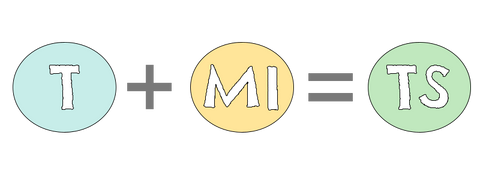
That’s it! Teaching these 3 simple steps now, will give your students a strong foundation on how to identify topic sentences.
Students will benefit from lots of practice!
Want to make is even easier? Use our Foundations of Topic Sentences resource. Activities are differentiated and broken down into finding the topic, main idea and finally the topic sentence!

Ready to give it a try? Here’s an example paragraph:
You have to wear certain clothing to play soccer. One thing you wear to play soccer is cleats so you can run easily on the grass. Another thing you wear during a soccer match is shin guards. You will also wear a jersey when you play soccer to show which team you are on. These are some things you wear to play soccer.
- Using our question prompts ask: “Who or what is the paragraph about?”
- Our topic of this paragraph is soccer.
- Ask “What is this paragraph MOSTLY saying about the topic?”
- Our main idea is soccer clothing.
- Ask “Which sentence combines the topic and main idea?
- Our topic sentence combines our topic: soccer + main idea: soccer clothing = topic sentence: You have to wear certain clothing to play soccer.
We don’t want to forget to teach our students these foundational skills. Each of these parts build on one another in order to help them learn the complete skill!
The best part?
Students who have a solid understanding of topic sentences will be better equipped to write topic sentences AND strong paragraphs!
As a teacher, educator, speech therapist or parent, teaching concepts using multi-modalities helps students access the information in different ways!
GRASPhopper wants to make sure everyone understands the steps to finding a topic sentences, so we’ve created a video lesson!
- The video will not only increase your knowledge of topic sentences, but can be used directly with your students too!
- This video is filled with opportunities for students to LEARN , with MODELS & EXAMPLES , and tons of opportunities to PRACTICE !
Excuse our digital dust! We’re busy renovating this website to make it even more fabulous. Stay tuned!
- Read more about: Writing
You might also like...
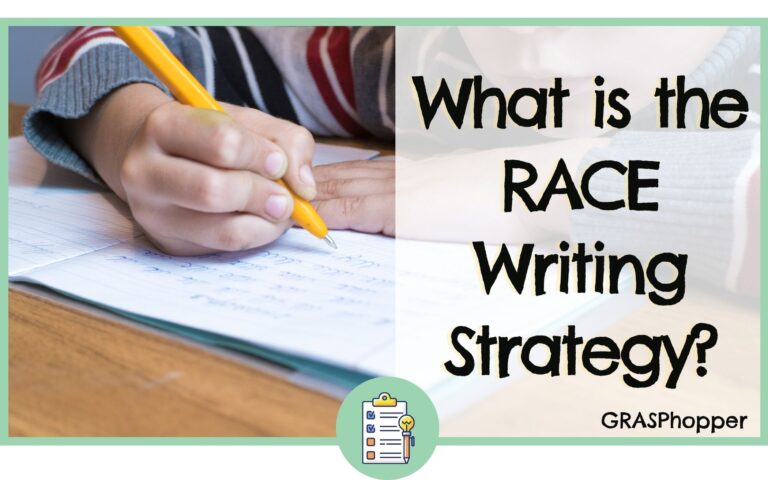
What is the RACE Writing Strategy?

The Best Paragraph Writing Worksheets for 5th Grade
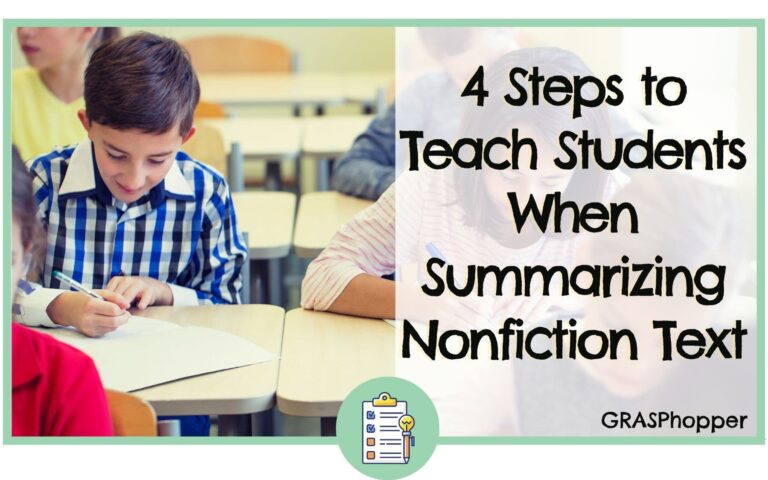
4 Steps to Teach Students When Summarizing Nonfiction Text

How to Effectively Teach Creative Writing in Elementary
Teach smarter, not harder join the newsletter.
Transform your teaching with our teaching tips, resources, and freebies delivered straight to your inbox!

The Goodies
© GRASPhopper Learning • Website by KristenDoyle.co
- Character Education
- Classroom Management
- Cultural Responsive
- Differentiation
- Distance Learning
- Explicit Teaching
- Figurative Language
- Interactive Notebooks
- Mentor Text
- Monthly/Seasonal
- Organization
- Social Emotional Learning
- Social Studies
- Step-by-Step Instruction
- Teaching Tips
- Testing and Review
- Freebie Vault Registration
- Login Freebie Album
- Lost Password Freebie Album
- FREE Rockstar Community
- Shop Teacher Finds
- Follow Amazon Teacher Finds on Instagram
- In the News
- Shop Writing Resources
- Shop Reading Resources
- Shop Social Studies Resources
- Interactive Writing Notebooks
- Interactive Reading Notebooks
- Social Studies Resources
- Rockstar Writers® Members Portal Login
- FREE MASTERCLASS: Turn Reluctant Writers into Rockstar Writers®
- Enroll in Rockstar Writers®

If you are looking for ideas to teach PARAGRAPH WRITING , you are in the right place! It is part of a STEP-BY-STEP WRITING® series of mini-lessons for writer’s workshop designed to scaffold through the writing process. Paragraph writing will extend through three posts (lessons 5 topic sentences, 6 relevant details, and 7 closing sentences). Now that your students are WRITING COMPLETE SENTENCES using the previous mini-lessons, they are ready to learn how to write a paragraph !
PARAGRAPH GRAPHIC ORGANIZER
To begin, show students a hamburger or turkey or vegan burger 😋 anchor chart . Tell them that you will be using a burger to explain how to write a paragraph. This will introduce all three lessons on paragraph writing and give them a visual. Get ready to write juicy paragraphs by learning about:
- TOPIC SENTENCE
- RELEVANT DETAILS
- CLOSING SENTENCE
The topic sentence is the top bun. It introduces the main idea of the paragraph. The relevant details talk about that main idea. It is the meat and veggies of the burger. The closing sentence is the bottom bun. It finishes the paragraph. Having this visual will help them “see” how to put a paragraph together!

TOPIC SENTENCES
MINI-LESSON #5 TOPIC SENTENCES is the first mini-lesson for paragraph writing.
Paragraphs need to have topic sentences. It is a way of organizing and expressing the main idea of the paragraph! (That is why I use MAIN STREET for the visual. Main Street-Main Idea. Get it?) This is the top bun of the burger!
A topic sentence:
- Answers questions like why, how, or where.
- Has supporting sentences or relevant details.
- Can prove, explain, or describe something.

Prompt example: What is your favorite season?
Paragraph : Fall is my favorite season. The weather is perfect for outside activities. I like going on hikes with my brother and fishing with my dad. I look forward to the smell of a fire and the taste of burnt marshmallows. I love fall weather!
Notice the underlined sentence is the topic sentence . It is the main idea of the paragraph. Everything else in the paragraph refers to fall being the favorite season. There are details that follow to answer “why” it is the favorite season.
2. TEACH INDENTS
This is the perfect time to introduce INDENTS ! Point out paragraph indentions in text books or stories to reinforce this lesson! Indents are when you move the first line of a paragraph to the right and create a space.
- It is usually 5 letter spaces.
- The first sentence of every paragraph should be indented to show where the paragraph begins.
- The rest of the sentences should be lined up on the left. If using notebook paper, these sentences should line up on the pink or red line.

3. TAKE NOTES
If using interactive notebooks , create something similar to the following. Students should take notes and give examples. This will provide them with an amazing reference to flip through when writing paragraphs in the future. When I walk around during a writing assignment and notice students who forgot to add a topic sentence, I remind them to use their notebooks. It works wonders! It is an effective tool to use in small groups and reteaching too.
If using a digital format, you can still have students write with interactive notes by having them move pieces and filling in text boxes!

4. PRACTICE
Provide students with practice. Practice, Practice, Practice! I like to scaffold the practice. First, students should identify topic sentences in paragraphs. Then students can write their own topic sentences. This can be done by giving writing prompts and only writing the topic sentence for each prompt. It can also be saved for the following lessons, so students can build paragraphs from the prompts. When all three lessons are completed, they will have all the components of a paragraph for those specific prompts! Use graphic organizers to keep flow of the lessons.
Task cards and self-check slides are a great way to give students extra practice in centers or at home.
5. GO DEEPER
Do you want your students’ topic sentences to have Rockin’ Beginnings? This can be used to differentiate in your classroom as well. Use the following anchor chart to help students write better topic sentences. I usually wait to introduce this skill with essay writing, but sometimes there are students who are ready earlier!
6. APPLY AND SHARE
Provide a prompt or have students brainstorm ideas for a paragraph. Then they can use these ideas to write a paragraph using a topic sentence. It is OK that you haven’t covered the other paragraph writing skills yet. You are only looking at the topic sentence! OR give students a paragraph without the topic sentence and have them add the topic sentence.
After everyone is finished, students can present their paragraphs in groups or whole group and other students can point out the topic sentence . Discuss why it is a topic sentence. Is it the main idea of the paragraph?
Whole group idea : As students are reading their paragraphs, ask other students to hold a hand up to their ears when they hear the topic sentence. It may help keep their attention!
7. ASSESS AND TRACK

NEXT LESSON: RELEVANT DETAILS
I hope this helps with your instruction! GET READY TO TURN YOUR RELUCTANT WRITERS INTO ROCKSTAR WRITERS ® !

Check out my FREE writing masterclass! CLICK HERE
CLICK HERE FOR THE FULL LIST OF WRITING MINI LESSONS
RESOURCES PREPPED AND READY FOR YOU

INTERACTIVE STEP-BY-STEP® WRITING PROGRAM ULTIMATE BUNDLE

Paragraph Writing Google Version

Paragraph Writing Prompts | Paragraph of the Week | Distance Learning

Sentence Structure and Paragraph Writing Google Version

Step-by-Step Paragraph Writing

Step-by-Step Paragraph Writing and Sentence Structure Unit

STEP-BY-STEP WRITING® Program for GOOGLE and POWERPOINT

The Perfect Paragraph Bundle | Lessons | Guided Prompts | Videos | Paragraph Writing

Upper Elementary STEP-BY-STEP WRITING® Grades 3-5
This lesson is also included in the STEP-BY-STEP WRITING ® Program with mini-lessons designed to scaffold through the writing process. Writing units included are sentence structure, paragraph writing, narrative writing, opinion writing, and informative writing. See what is included in the image below and click on it to learn more about them! You will turn your reluctant writers into ROCKSTAR WRITERS ® !

ROCK ‘N WRITE!
SEE RELATED BLOGS:

Writing Mini Lesson #4- Run-On Sentences
Writing mini lesson #6- relevant details.

Reading Worksheets, Spelling, Grammar, Comprehension, Lesson Plans
Topic Sentences Worksheets
Topic sentences are a vital part of paragraph writing. They state the central focus of the paragraph and provide cohesion for the paragraph. It’s important for students to learn to write clear and concise topic sentences. The worksheets below are aimed to help your student become a master at recognizing and writing topic sentences. They are free for you to use at home or in the classroom. To view a worksheet or download a printable PDF, simply click on the title. Check out all of our writing worksheets !
Identify the Topic Sentence
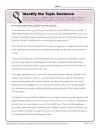
The topic sentence in a paragraph states the main idea of the paragraph. While it is usually at the beginning of the paragraph, it also can be in the middle or end of it. Students underline the topic sentence in each activity.
Paragraphs and Topic Sentences: Informational
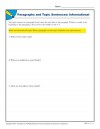
This worksheet includes a list of informational topics. Students write a paragraph on each topic and underline their topic sentence.
Paragraphs and Topic Sentences: Opinions
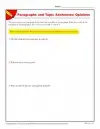
This activity includes a list of opinion topics. Students write a paragraph on each topic and underline their topic sentence.
Topic Sentence: What’s the Topic?
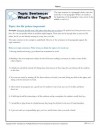
Students read the topic sentences provided and write what they think the topic is for each.
Write the Topic Sentence
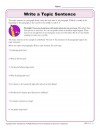
In this activity, students write a sentence for each of the topic sentences provided.
6 Exercises for Teaching Topic Sentences
Why should students learn about topic sentences?
A topic sentence is the most important sentence in a paragraph. It tells the reader what the paragraph is about. If you don’t know how to write a topic sentence, your paragraph will probably be confusing. A well-written topic sentence can make your paragraph more interesting.
1 Introduction to topic sentences quiz
This quiz is a nice way to introduce topic sentences.
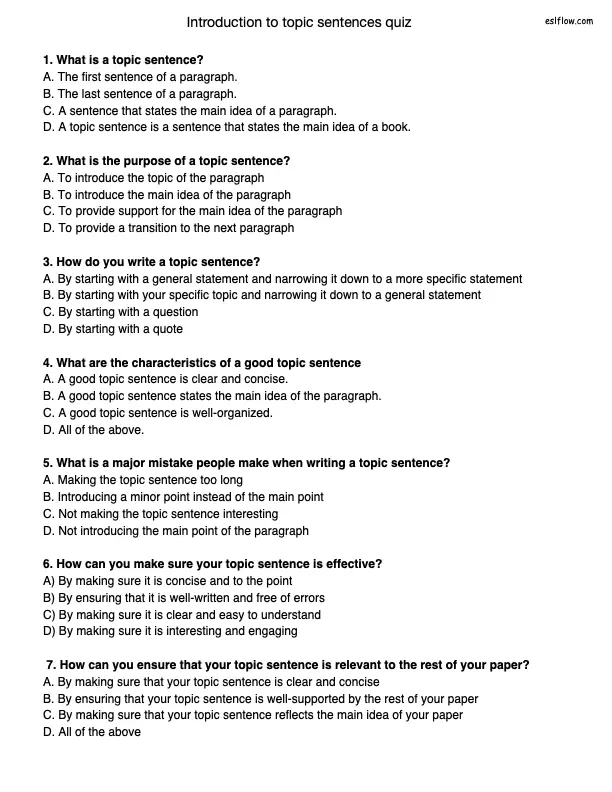
(download PDF)
Subscribe to Eslflow
Subscribe to get full access to the latest and best resources from eslflow.com . There are no ads in the newsletter and you will receive entertaining, high quality, and up-to-date teaching resources regularly. Also, if you take out a paid subscription, you can download large collections of PDF, audio and video materials in zip files.
2 Sentence starters for topic sentences
Sentence starters provide an easy and smooth way of getting students familiar with topic sentences.
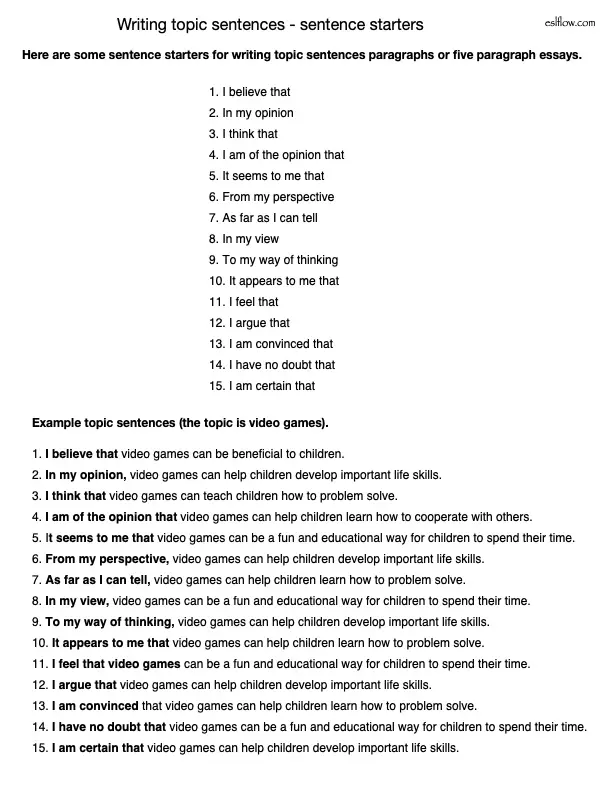
3 Understanding topic sentences
Topic sentences are essential for summarizing the main idea of an essay. This worksheet can be used to test students’ understanding of topic sentences.
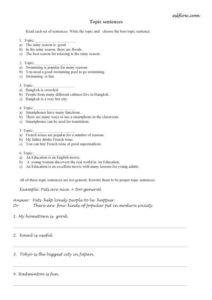
Understanding topic sentences exercises (PDF)
4 Writing topic sentences for essays and paragraphs (with possible answers)
In this worksheet students practice writing topic sentences by looking at the pictures, thinking about what kind of essay each picture might inspire, and writing an appropriate topic sentence.
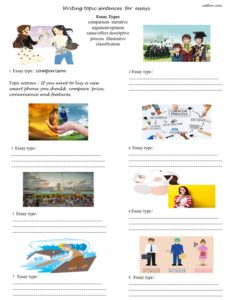
Writing topic sentences exercise (PDF)
5 Creating topic sentences from supporting ideas
This is another way to help students understand the function of a topic sentence.
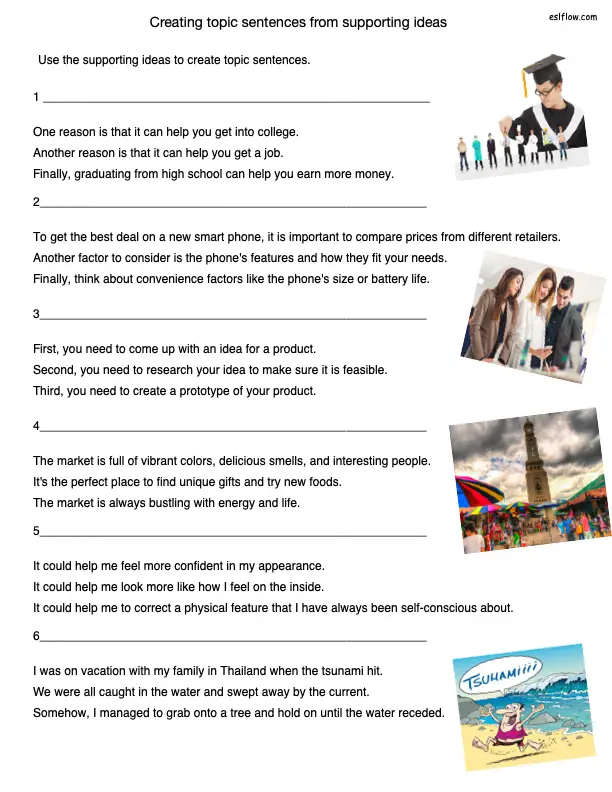
6 Writing topic sentences for paragraphs or essays (with possible answers)
Topic sentences are essential for summarizing the main idea of a paragraph. Paragraphs often have topic sentences supported by three ideas. So in this worksheet students practice writing topic sentences by looking at the pictures and trying to summarize three ideas in one topic sentence.
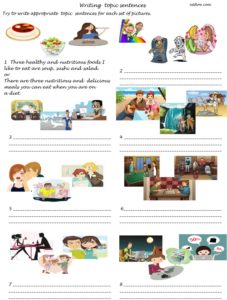
Writing topic sentences for paragraphs or essays (PDF)
Related Resources:
10 opinion and argument writing worksheets
8 comparison/contrast templates and exercises
10 cause/effect writing activities
3 kinds of exercises for teaching transitions
6 memorable narrative essay writing practice exercises (PDF)
6 delightful descriptive paragraph and essay writing exercises (PDF)
7 Finding and creating topic sentences
This is a useful exercise to help students identify and create topic sentences.
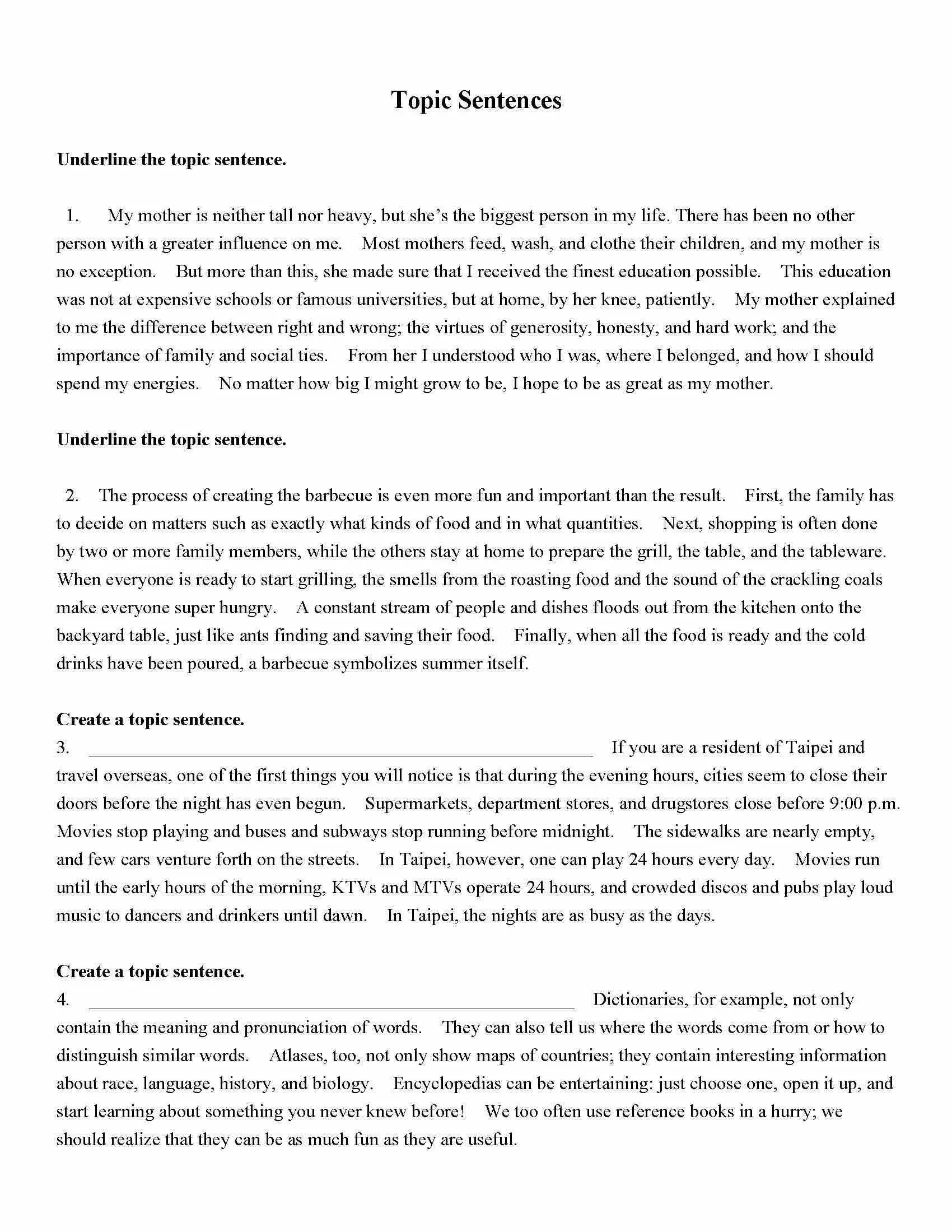
Other resources
Daily routines, schedules and other present simple listening speaking activities
Comparative adjectives
- Sentence starters
Gerunds and infinitives
Import export and supply chain language exercises

Leave a Reply Cancel reply
Your email address will not be published. Required fields are marked *
Save my name, email, and website in this browser for the next time I comment.
This site uses Akismet to reduce spam. Learn how your comment data is processed .
RECENT ESL EXERCISES
- Essential listening exercises for ESL classes
- Daily routines and schedules
- Writing topic sentences
- Shopping online listening, speaking and vocabulary
- Import/export, logistics and supply chain exercises
- Create a conversation
- Using comparative adjectives
- Gerunds and Infinitives Grammar, Speaking and Listening Activities
Get Unlimited Printing, Downloading, and No Ads!
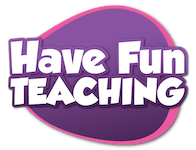
Writing Topic Sentences Worksheet

Description
- Reviews (0)
How to teach Writing
Using this Writing Topic Sentences Worksheet, students write a broad topic and then write a limited topic that connects.
A paragraph should begin with a topic sentence, or main idea. The rest of the paragraph is comprised of sentences that provide specific details which support and develop the main idea. This worksheet helps your students write a good paragraph that contains transitional words that unify the sentences and create flow.
Write a broad topic. Next, write a limited topic. Then, write a topic sentence for the the limited topic.
Other resources to use with this Writing Topic Sentences Worksheet
If you are using this worksheet, your students are probably learning about writing paragraphs.
Use this Organizing Writing Paragraphs Worksheet as an additional resource for your students.
Introduce this worksheet by students sharing what they know about a topic. Have students tell a partner for 2-3 minutes. Next, ask students share how organized their information was. Students give ideas about how to make their paragraphs more organized. Then, students complete worksheet independently or with a partner. Finally, students share their passages with a partner.
Be sure to check out more Writing Worksheets .
Please write a review!
Tell others why you love this resource and how you will use it.
There are no reviews yet.
You must be logged in to post a review.

Customer Reviews
"HFT has helped my son enormously with his clarity of speech and knowledge of letters, consonants, vowels, and math skills. A BIG thank you from us all.” Charlotte H.
"Every teacher and parent should be using HFT. Your kids will thank you for it!” Jess B.
Subscribe and Save!
With an HFT Subscription you get unlimited printing, downloading, and video streaming!
- Instant access to our entire library of resources
- Worksheets, Games, Songs, and More
- Unlimited downloading, printing, and streaming
- Ad-Free website experience
Phonics Worksheets Reading Comprehension Worksheets English Worksheets Math Worksheets
Pricing Get a Subscription FAQ Purchase Orders
About Us Terms of Use Privacy Policy Shipping and Returns
Contact Us Email the Owners Report a Problem Blog
© 2005 - 2024 Have Fun Teaching | All Rights Reserved
- Tufts Faculty Working Together to Teach for Racial Equity
- Giving Feedback on Student Writing
- Reconsidering Academic Writing from a Culturally-Informed Perspective
- Supporting Student Success with Document Headings
- Reconsidering and Revaluing Academic Writing in the Age of AI

Teaching@Tufts
Supporting excellence in learning and teaching at Tufts University
Teaching with Writing
Writing assignments – whether in the form of a research paper, lab report, reading response, article summary, artist’s statement, or creative writing – are such a standard component of so many courses that faculty may take the value of writing for learning and thinking as a given. It has always been important to know how each assignment helps students to work towards your course’s learning objectives, but the ability of AI to generate written artifacts in moments challenges us to reflect on the value and purpose of writing, and to define and explicitly communicate to students the benefits of writing and the writing process.
Why Writing?
In an essay on the future of writing for the Chronicle , Corey Robin argues that “academic writing has never simply been about producing good papers. It’s about ordering one’s world, taking the confusion that confronts us and turning it into something intelligible, wresting coherence from chaos.” Emphasizing process underscores how writing helps us to grapple with complexity: to articulate ideas, to analyze arguments, and to deepen reflection. For guidance on reflecting on, defining, and communicating the role of writing in your course read more here .
Offering Feedback on Writing
The strongest writing, like the deepest thinking, does not happen in isolation; it benefits from feedback. In a genuine effort to prompt student learning, however, instructors often provide an overabundance of written edits and feedback without prioritizing it, which can cause confusion for students and overwork for the instructor. For some considerations for approaching feedback on student writing read more here .
See Also –
Disclaimer | Non-Discrimination | Privacy | Terms for Creating and Maintaining Sites

IMAGES
VIDEO
COMMENTS
Briefly, here are each of the five topic sentences I introduce: 1. List Statements: A List Statement tells the reader exactly what the paragraph will be about by listing the three supporting ideas. For example: My favorite sports include soccer, football, and basketball. 2.
Every time I teach a specific component of writing — like creating the topic sentence in an informative text — I end up writing my own example as a mentor text for students to dissect. After doing this for years, this incredible set of mentor texts was designed specifically to help you teach students about specific parts of writing .
To accomplish this goal, I teach my students a few tools to start their paragraphs in an interesting way. Use a bold statement. Use a quote. Ask a question. Cluster a few adjectives at the beginning of the sentence. Start your sentence with a conjunction. One of my favorite activities to reinforce this skill is to have my students take dull and ...
Writing short, effective topic sentences can often be a make or break skill at the college level. I noticed my students have been writing 3-4-5 line topic sentences. I wanted to teach them to write short, effective introductory topic sentences. Also, this activity allowed me to teach backwards outlining- the topic sentences they re-wrote became ...
Topic sentences aren't the first or the last thing you write—you'll develop them throughout the writing process. To make sure every topic sentence and paragraph serves your argument, follow these steps. Step 1: Write a thesis statement. The first step to developing your topic sentences is to make sure you have a strong thesis statement ...
This paragraph allows them to zoom in and see how their topic sentences relate to their thesis and to each other. Schedule: Week 8-9 (but could be used any time between the draft of an assignment and the due date for the final version of that assignment) Activity length: Appox. 40 minutes. Activity goals: Sharpen use of topic sentences; focus ...
As with all writing, teachers should first model proper topic sentences to have students identify the topic and the claim in the sentence, regardless of the academic discipline. For example, these models of topic sentences inform the reader about a topic and the claim that will be supported in the paragraph: Topic Sentence: " Pets are important ...
Teaching learners how to identify topic sentences is a good idea, especially for exams. Learners can be encouraged to highlight the topic sentence in each paragraph as they read. An effective extension activity is to then use these as the basis for summary writing. Further links:
In Writing Well, Thinking Clearly, we provide five tips for writing a good topic sentence. When we conduct workshops based on the writing guide, we often field questions about these tips. In this post, I will provide further explanation and examples of each tip. 1. Generally, topic sentences should not be compound but could be complex.
Under the last umbrella, I could write the following topic sentence: The Burmese python kills its prey in a unique way. So far, this illustration I used to teach students how to write topic sentences has been wonderful! I even brought in a big umbrella and a smaller one as an illustration.
Give students in middle or high school an envelope with four sentences, each on its own strip of paper. In groups, have them organize the sentences in a logical order, beginning with the topic sentence. Ask them to highlight the strip that is the topic sentence. You can also give middle and high school students an envelope with three to five ...
* Writing paragraphs: Students write the topic sentence in the middle box. They write a sentence containing a supporting detail in three of the squares and they write a concluding sentence in the ...
Step #1: Find the topic. Using our question prompts ask: "Who or what is the paragraph about?". Our topic of this paragraph is soccer. Step #2: Find the main idea. Ask "What is this paragraph MOSTLY saying about the topic?". Our main idea is soccer clothing. Step #3: Find the topic sentence.
Scaffolding the Topic Sentence. Looking at the word bank, notice that we are scaffolding the learning for an early writer: jelly, toast, make. From these words and looking at the picture, we can figure out the main idea is making jelly toast. Start with using the I do, we do, you do scaffolding model.
Students should be encouraged to learn words they frequently misspell, as well as words they wish to include in their writing. Teachers also should help students acquire the skills they need to generate and check plausible spellings for words. 3. Teach students to construct sentences for fluency , meaning and style.
If you are looking for ideas to teach PARAGRAPH WRITING, you are in the right place!It is part of a STEP-BY-STEP WRITING® series of mini-lessons for writer's workshop designed to scaffold through the writing process. Paragraph writing will extend through three posts (lessons 5 topic sentences, 6 relevant details, and 7 closing sentences).
It's important for students to learn to write clear and concise topic sentences. The worksheets below are aimed to help your student become a master at recognizing and writing topic sentences. They are free for you to use at home or in the classroom. To view a worksheet or download a printable PDF, simply click on the title.
6 Writing topic sentences for paragraphs or essays (with possible answers) Topic sentences are essential for summarizing the main idea of a paragraph. Paragraphs often have topic sentences supported by three ideas. So in this worksheet students practice writing topic sentences by looking at the pictures and trying to summarize three ideas in ...
How to teach Writing. Using this Writing Topic Sentences Worksheet, students write a broad topic and then write a limited topic that connects. A paragraph should begin with a topic sentence, or main idea. The rest of the paragraph is comprised of sentences that provide specific details which support and develop the main idea.
Show and Tell: Display an interesting image or picture in front of your students. It could be anything from a serene landscape to a busy cityscape. Descriptive Writing: Encourage your students to write a paragraph describing what they see in the picture. Emphasize the importance of including a topic sentence, supporting details, and a conclusion.
Topic Sentences. When writing a text, we organize our writing into paragraphs, which are sections of writing focused on particular themes, or topics. The topic sentence is the sentence in the ...
In this free paragraph structure worksheet, students review the four basic parts of an academic paragraph and practice writing topic sentences, supporting ideas, supporting details, and concluding sentences. Students begin by reading a paragraph to identify its basic structural components. Students then match sentence halves to reveal an ...
I have found using specific topic sentence and conclusion sentence frames makes writing a paragraph much easier. This includes:*picture cards for topic ideas*2 topic sentence frames*3 types of conclusions*anchor charts of each to display*topic sentence and conclusion activities*paragraph draft pages (2 including traceable frames)See my store for more writing products.Revising Writing with ...
Teaching with Writing - Teaching@Tufts. Teaching with Writing. Writing assignments - whether in the form of a research paper, lab report, reading response, article summary, artist's statement, or creative writing - are such a standard component of so many courses that faculty may take the value of writing for learning and thinking as a ...